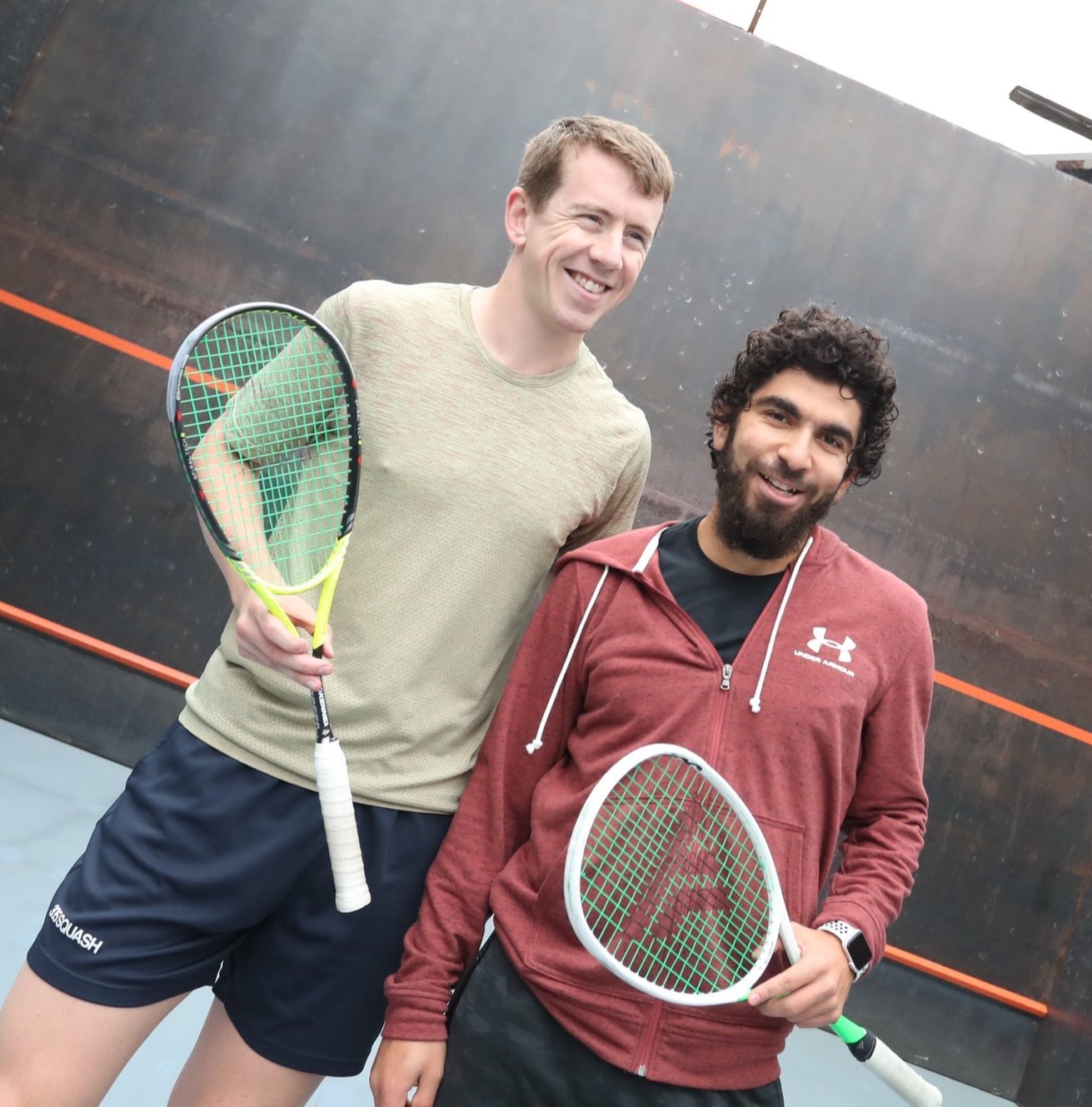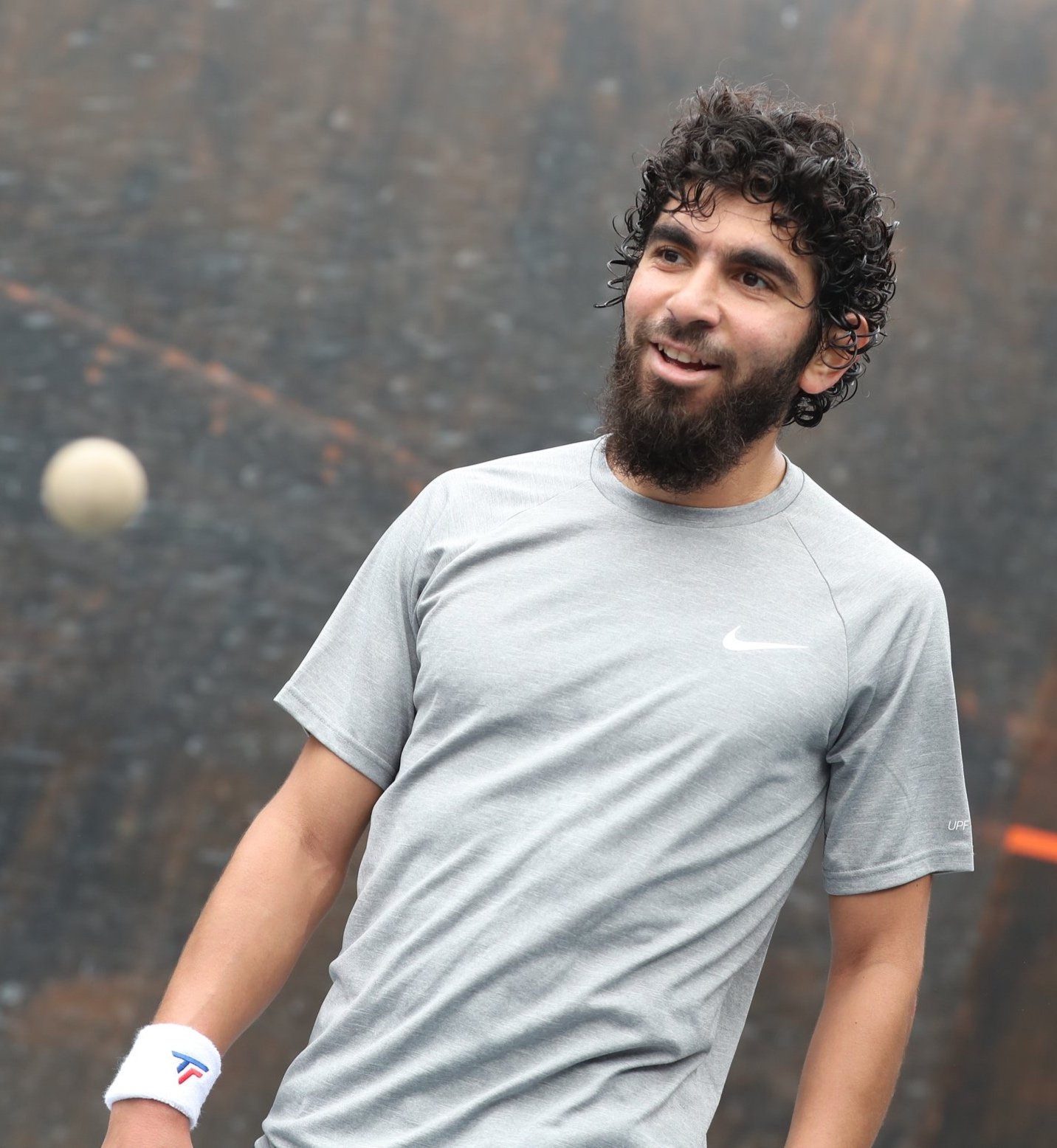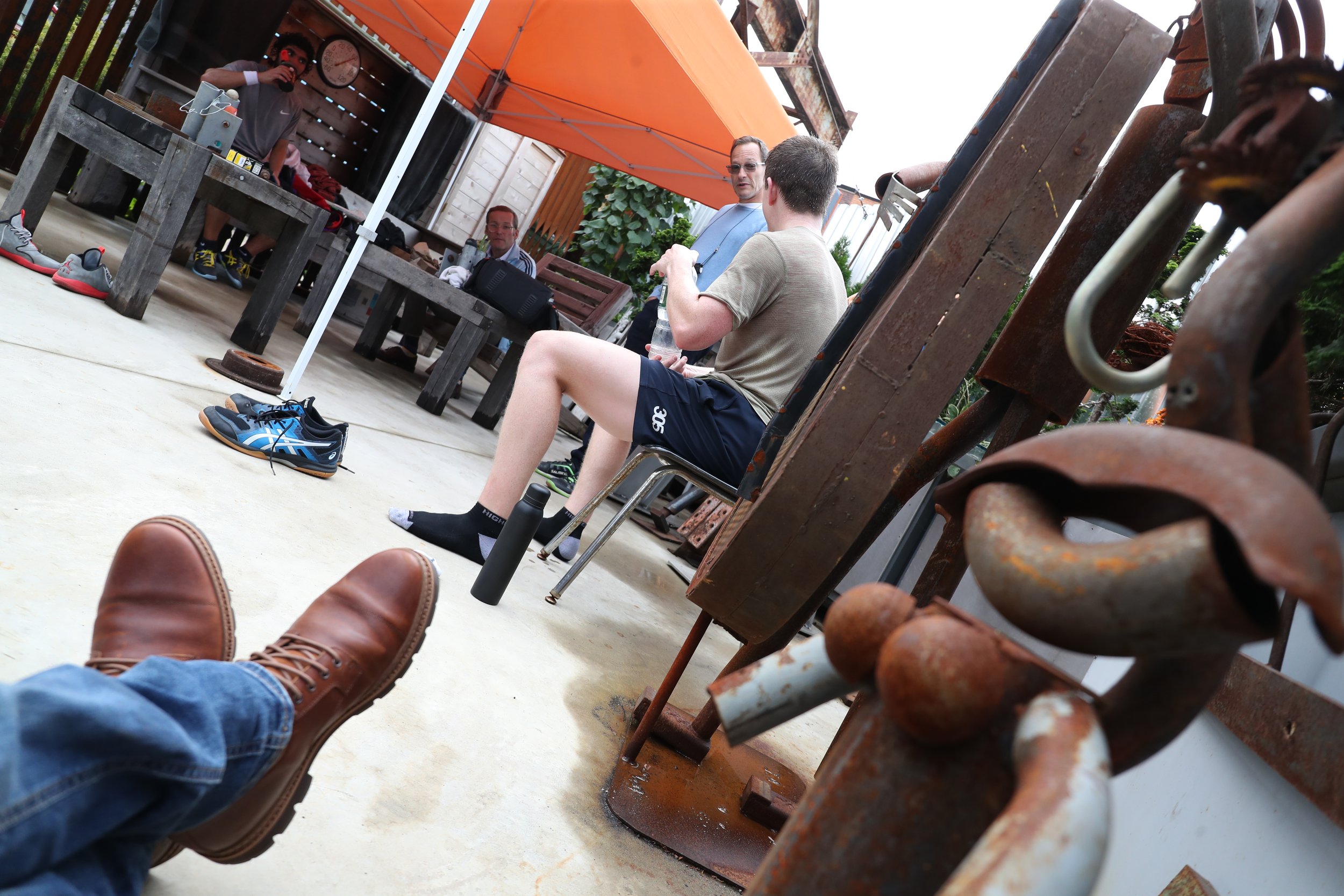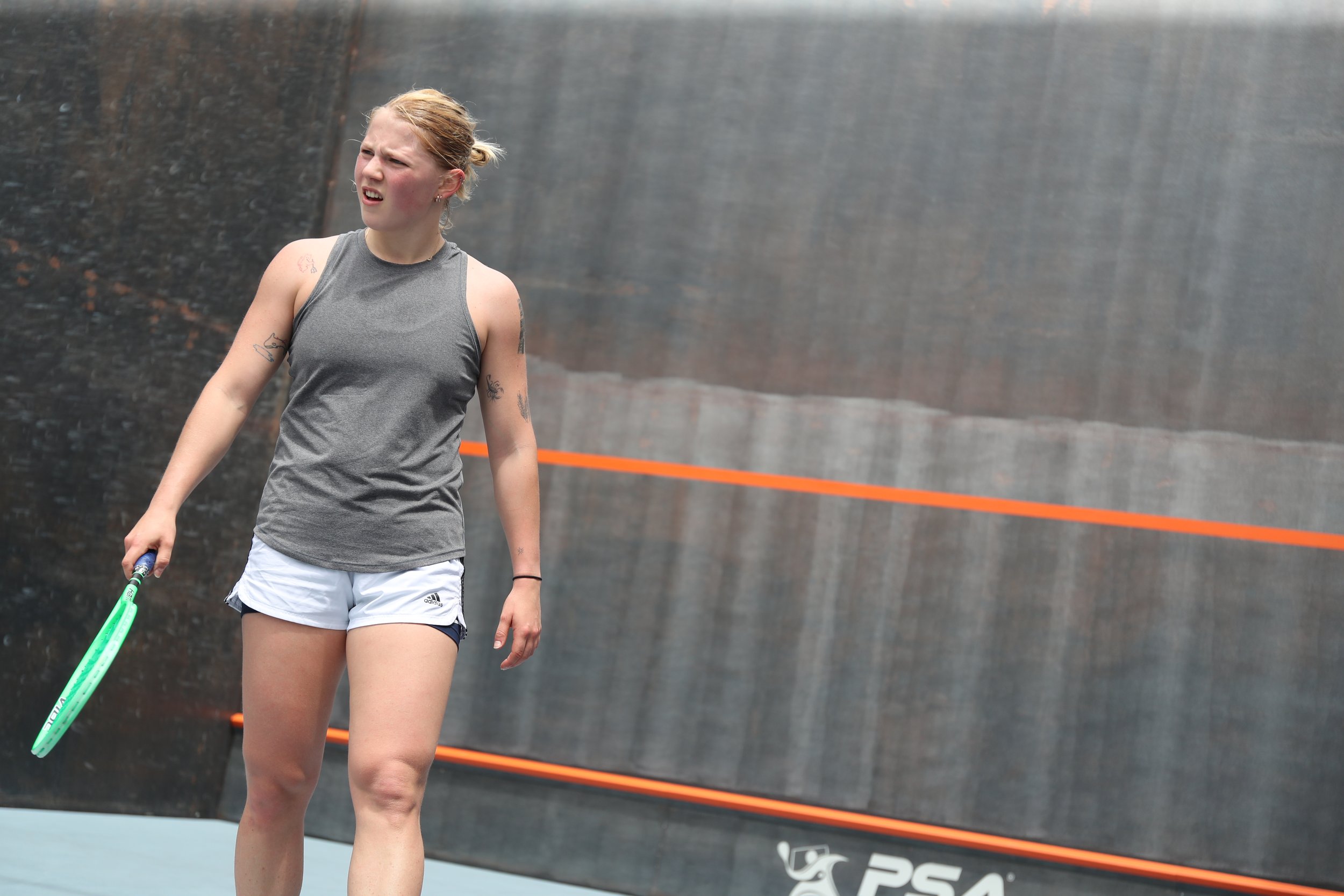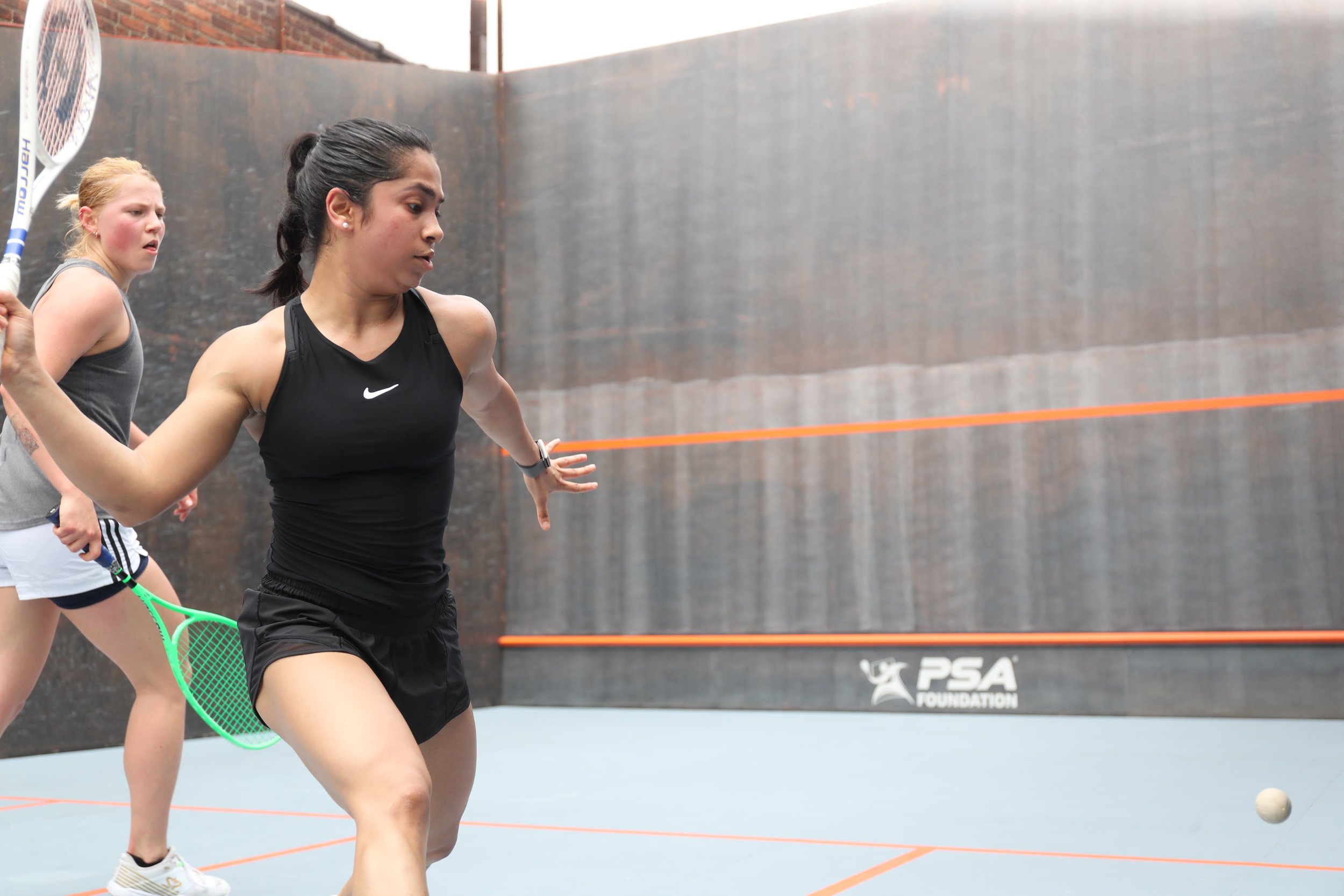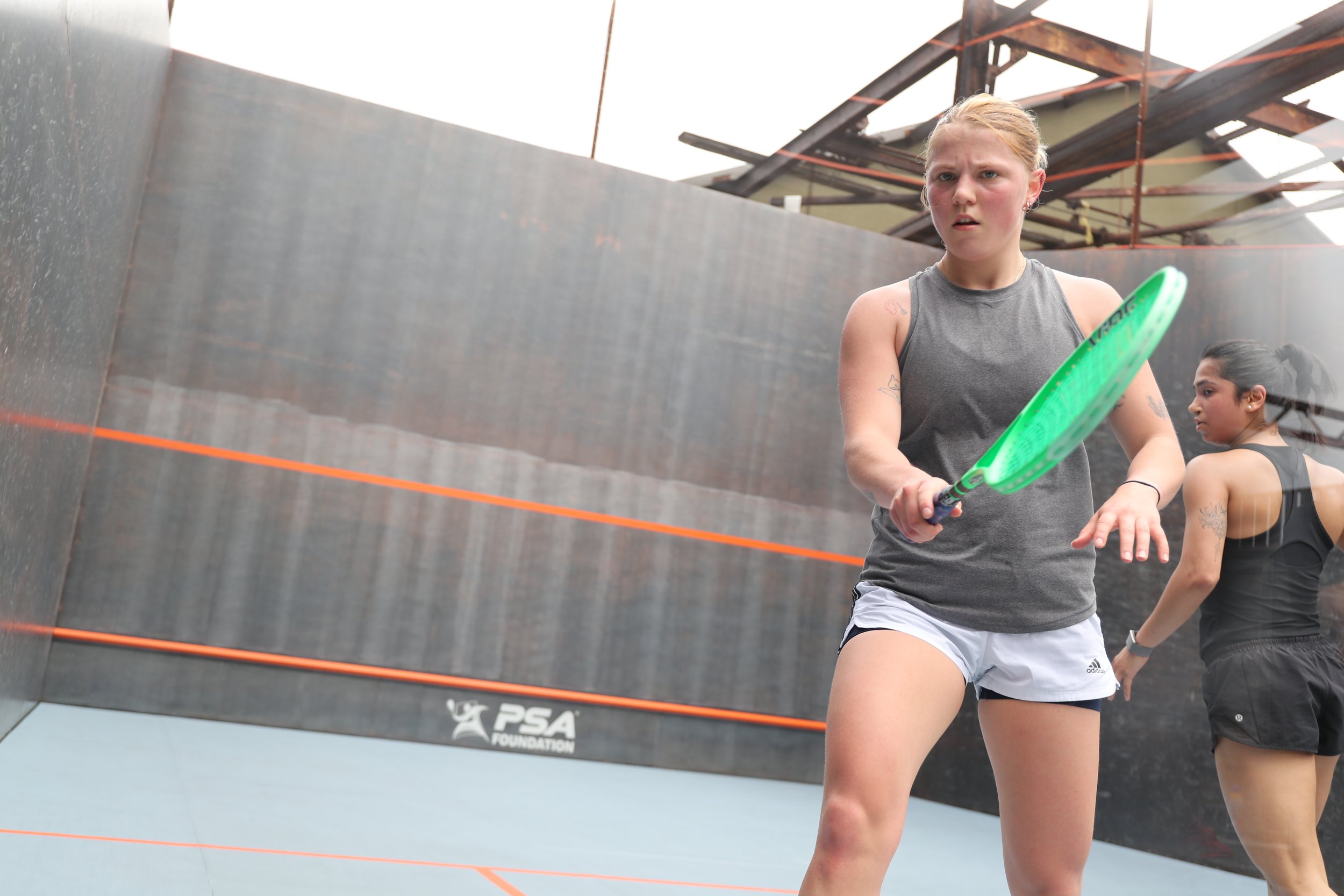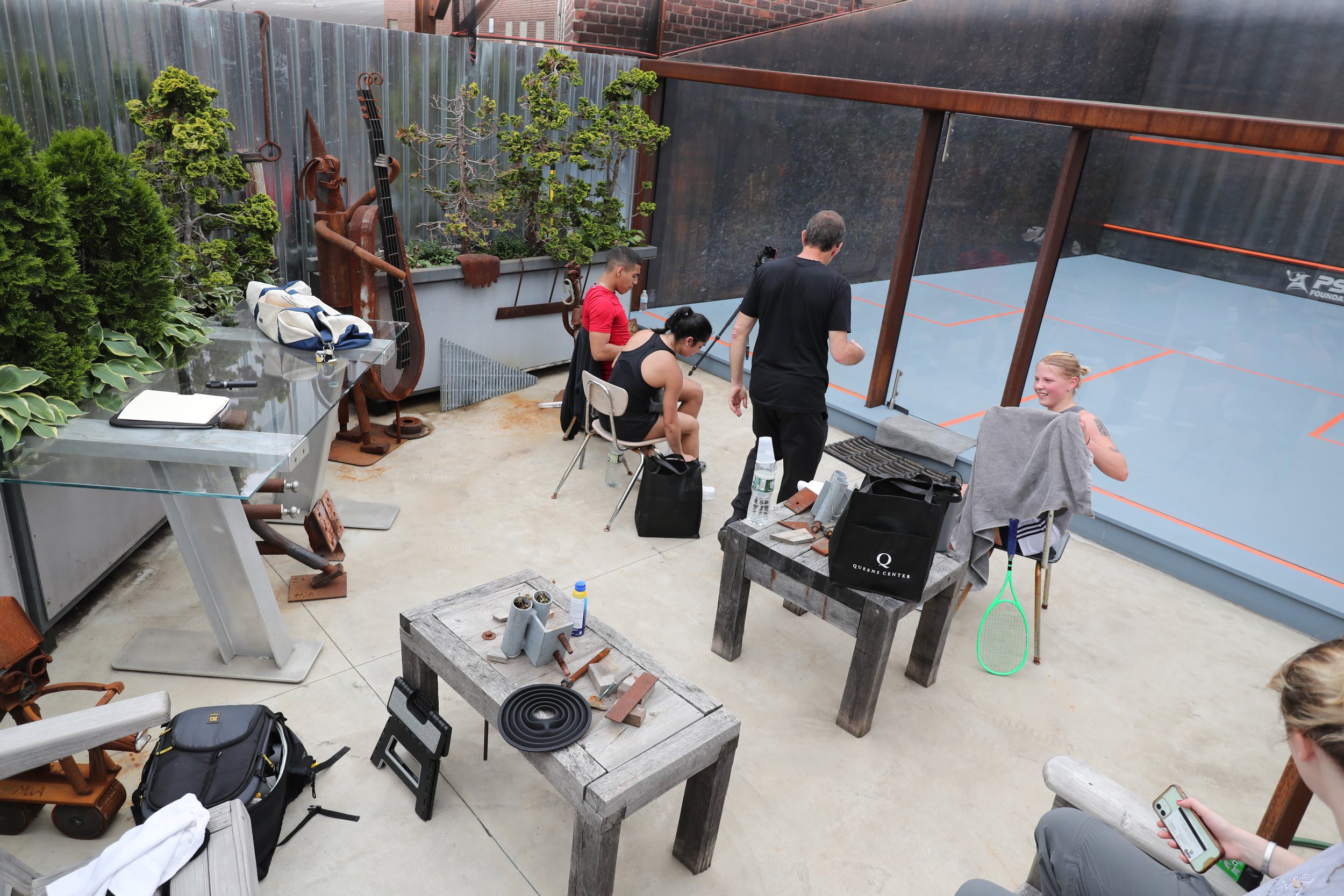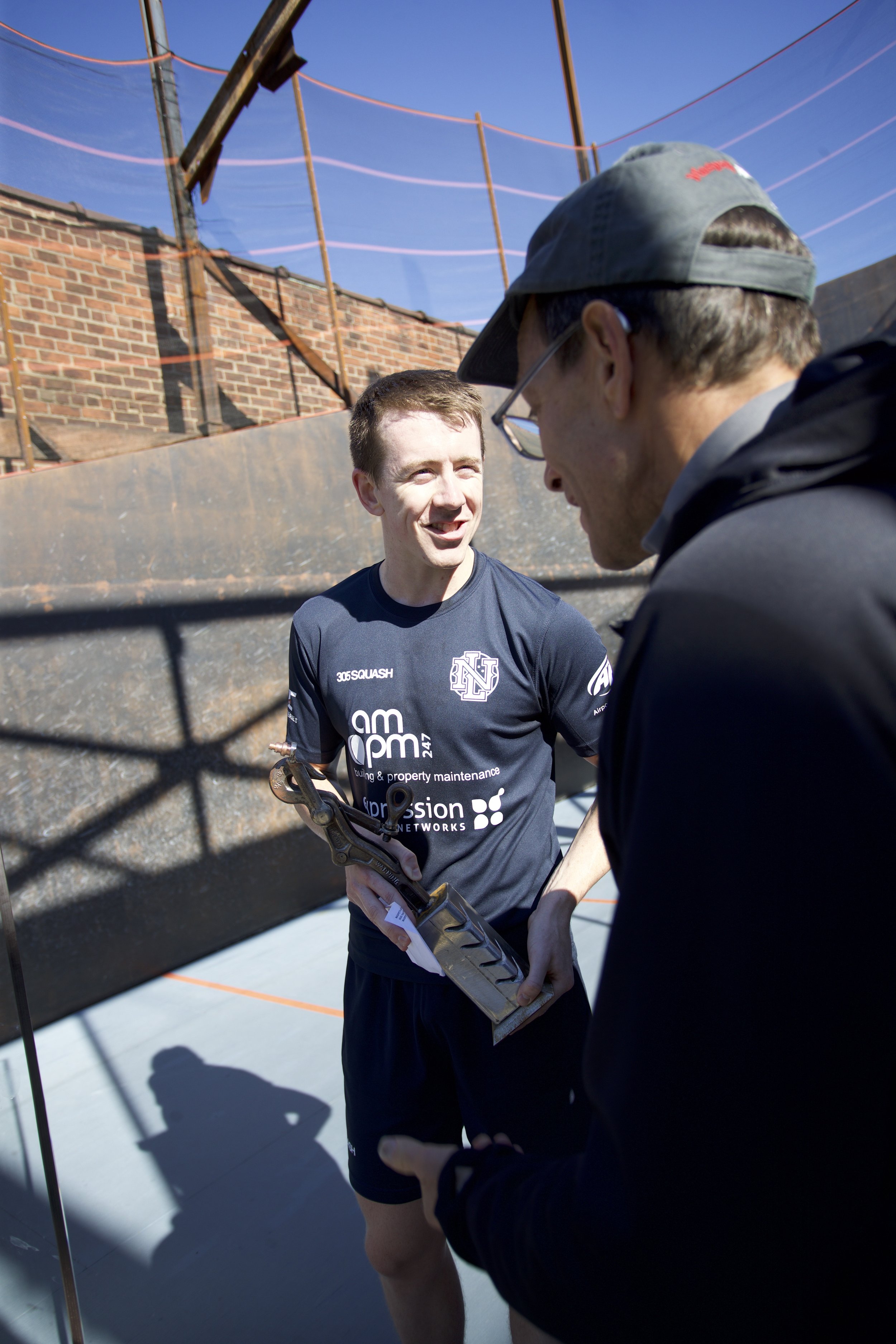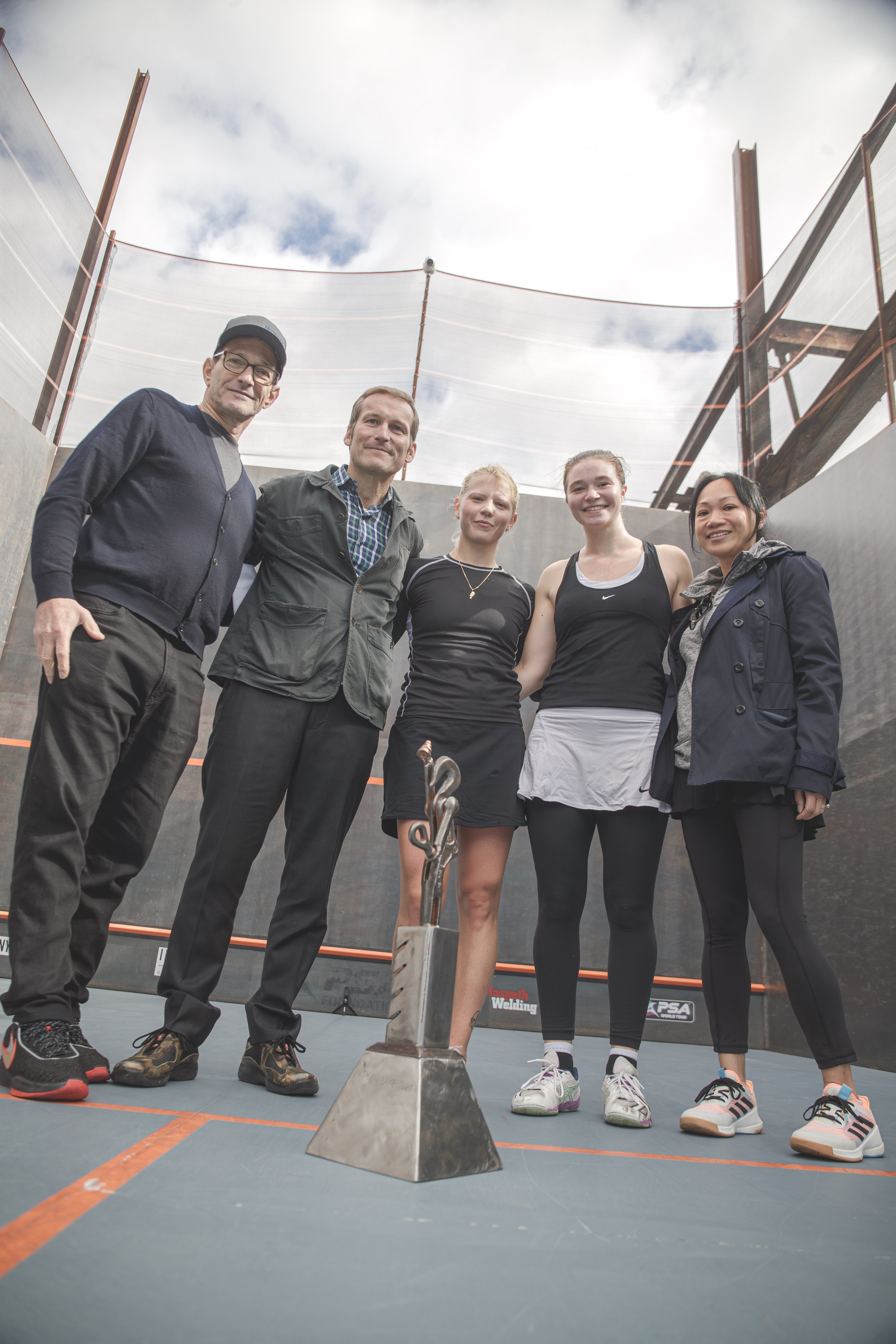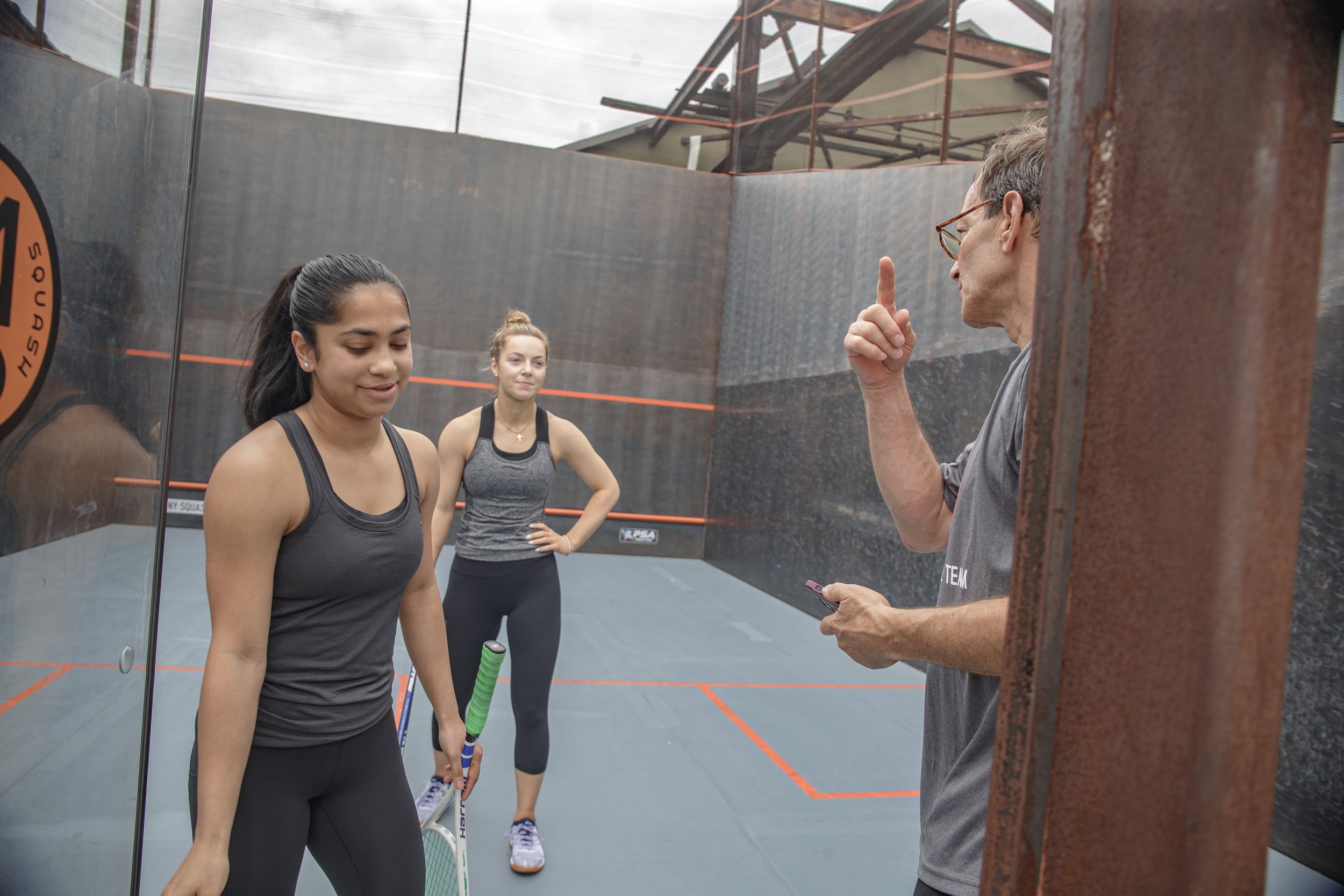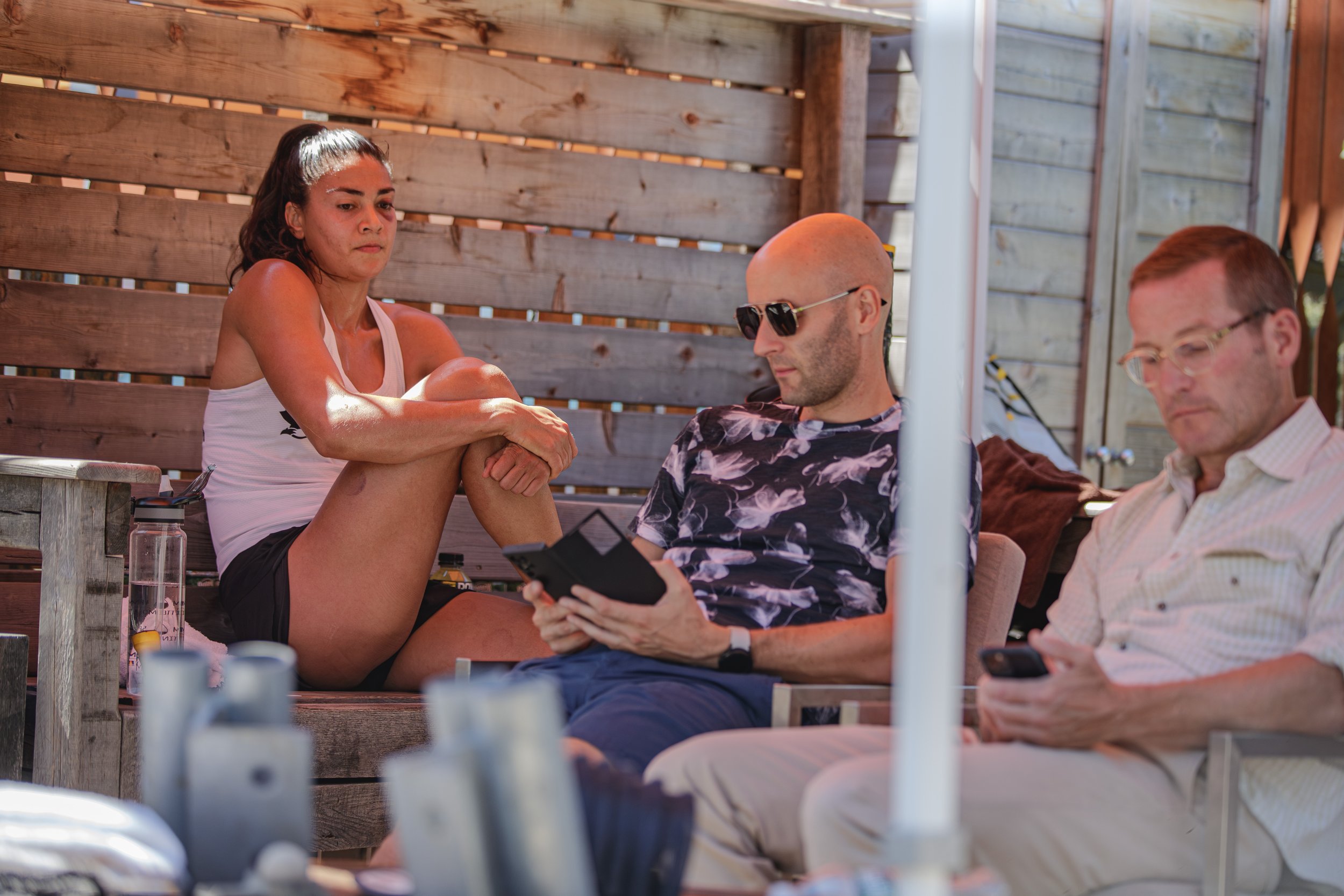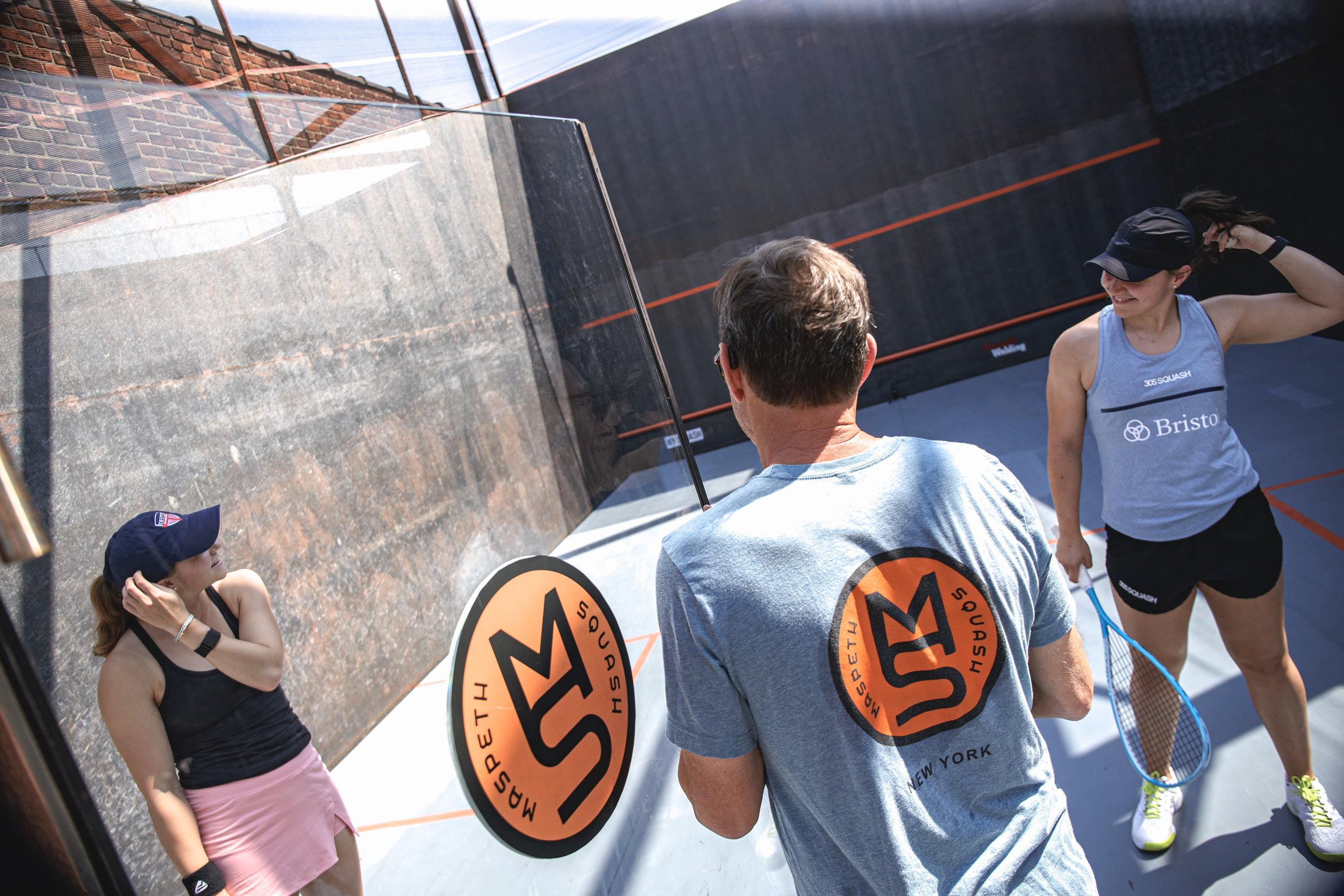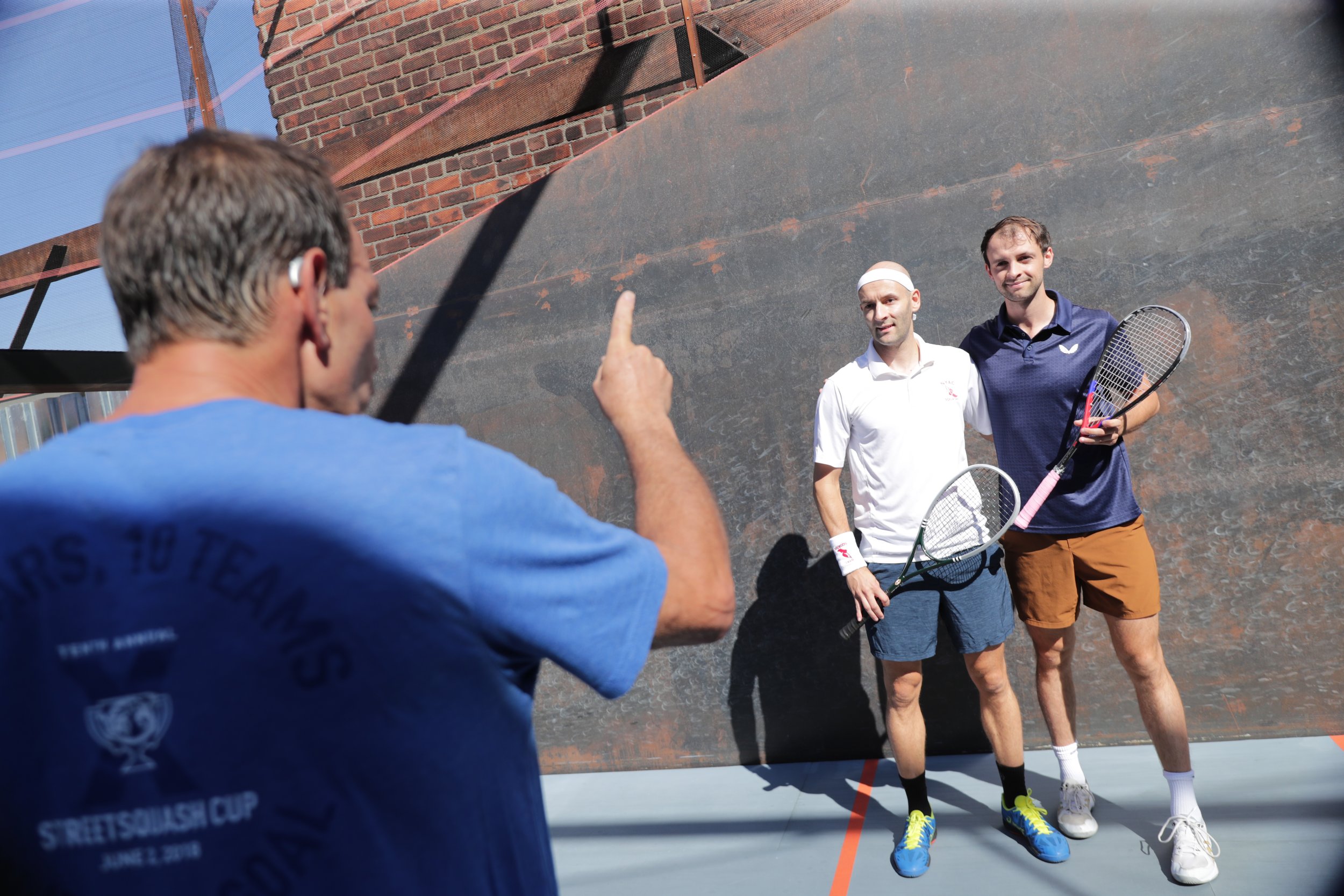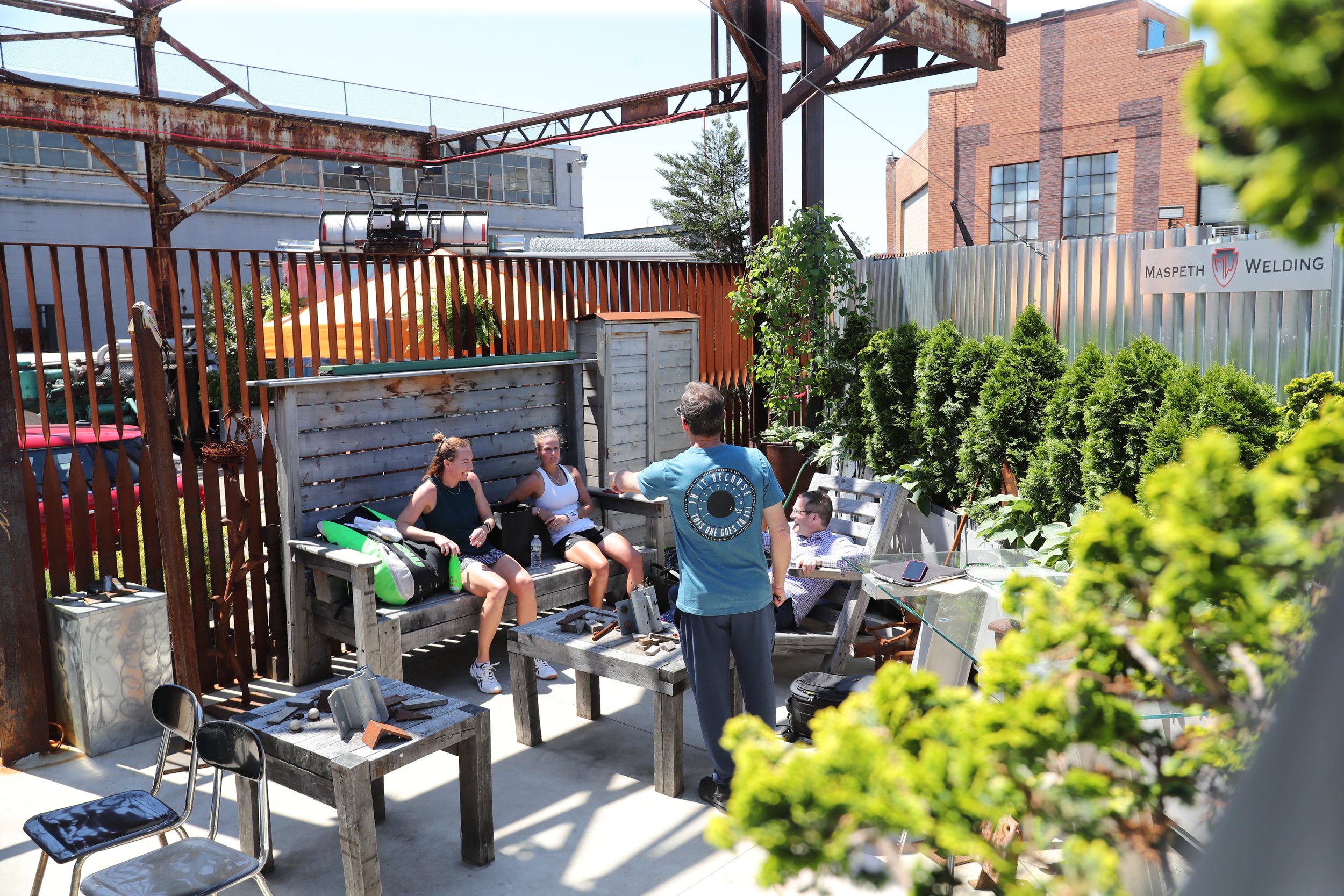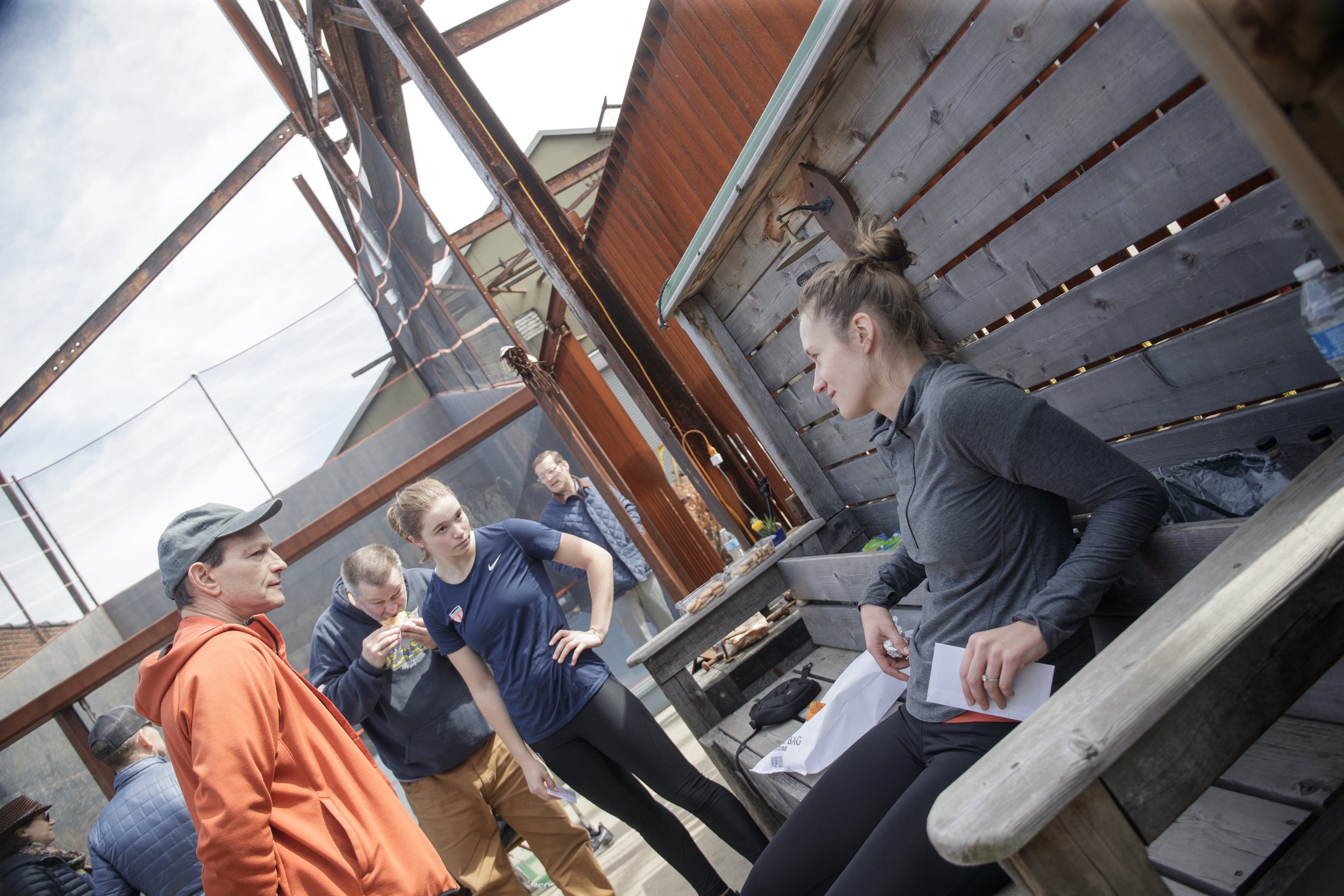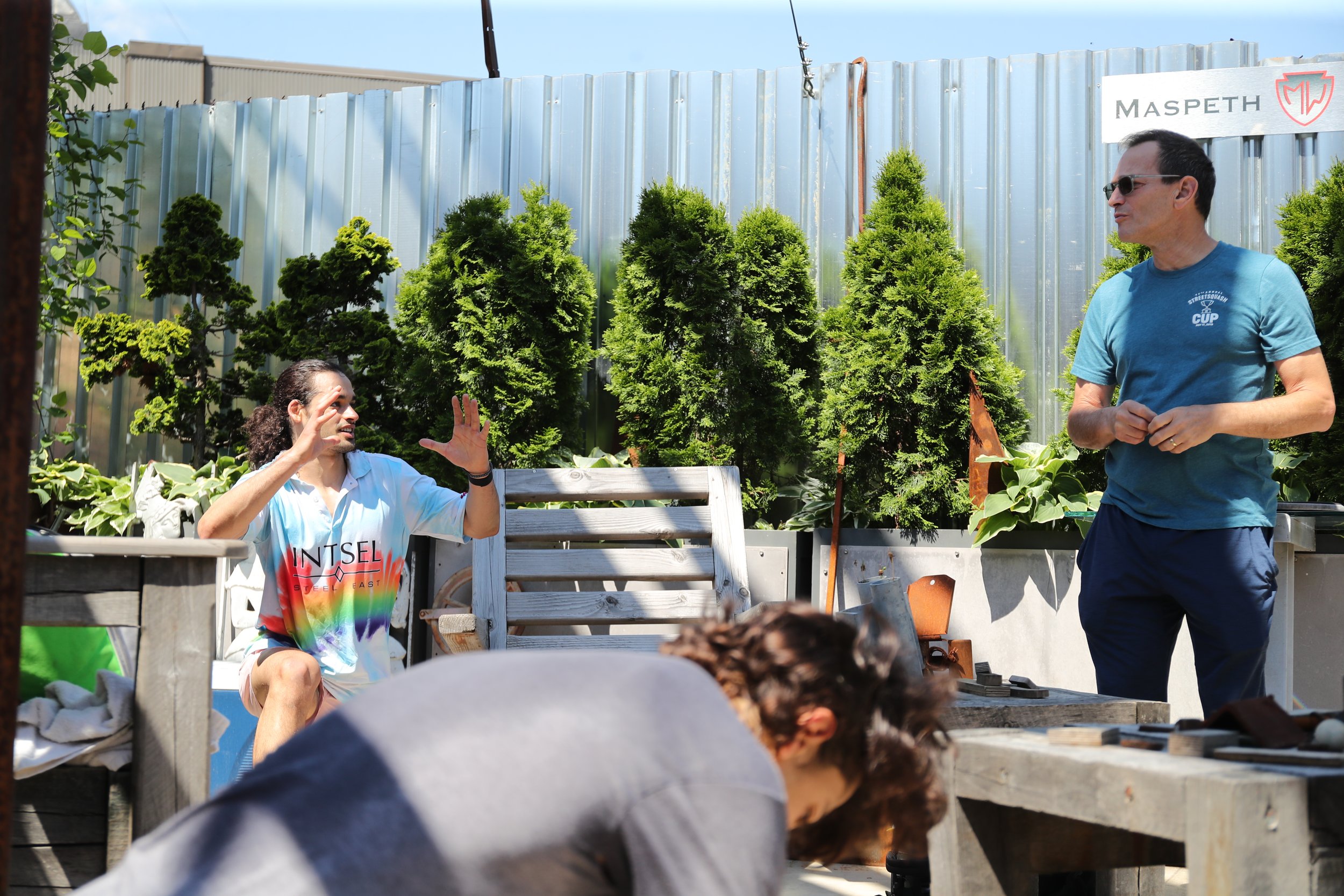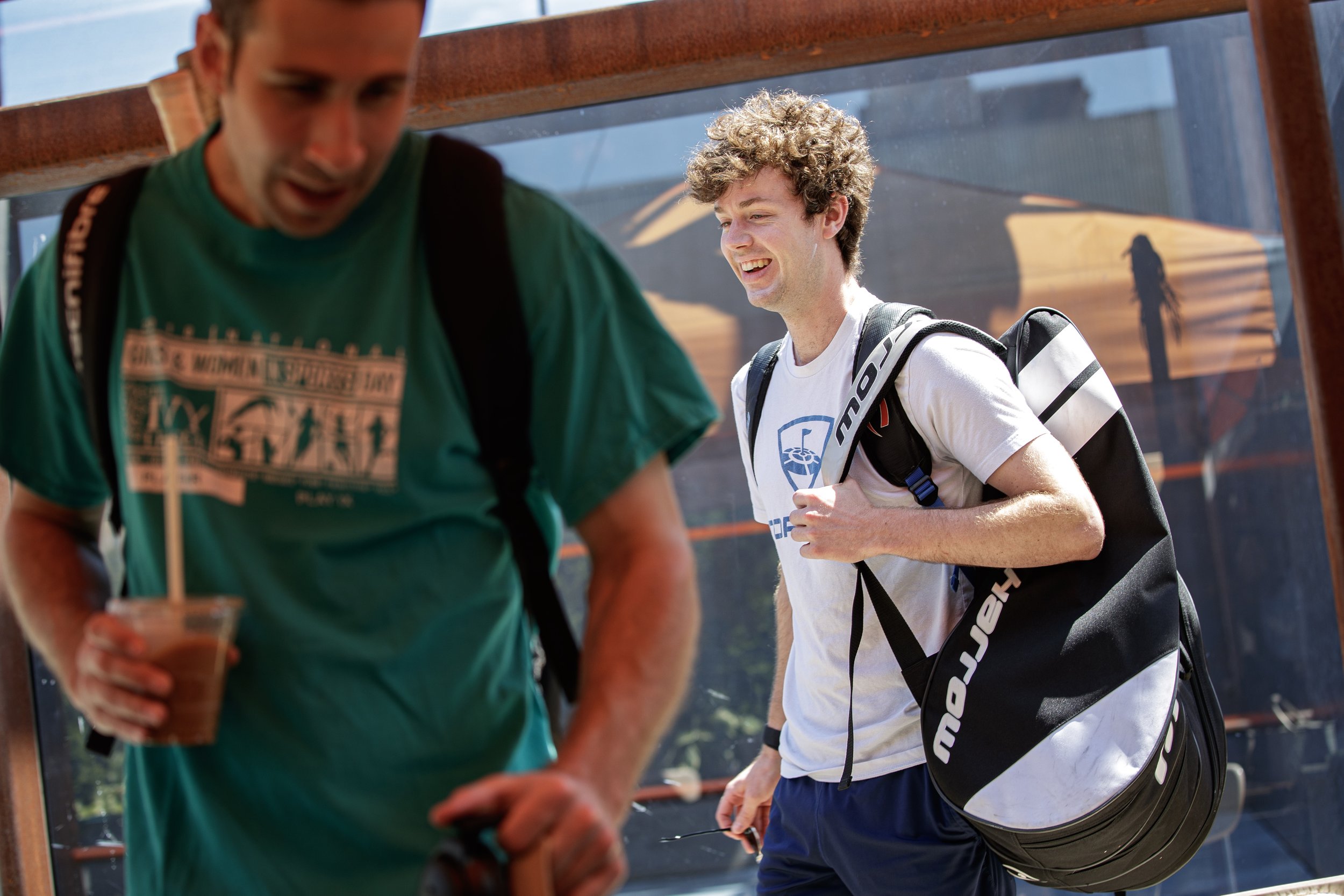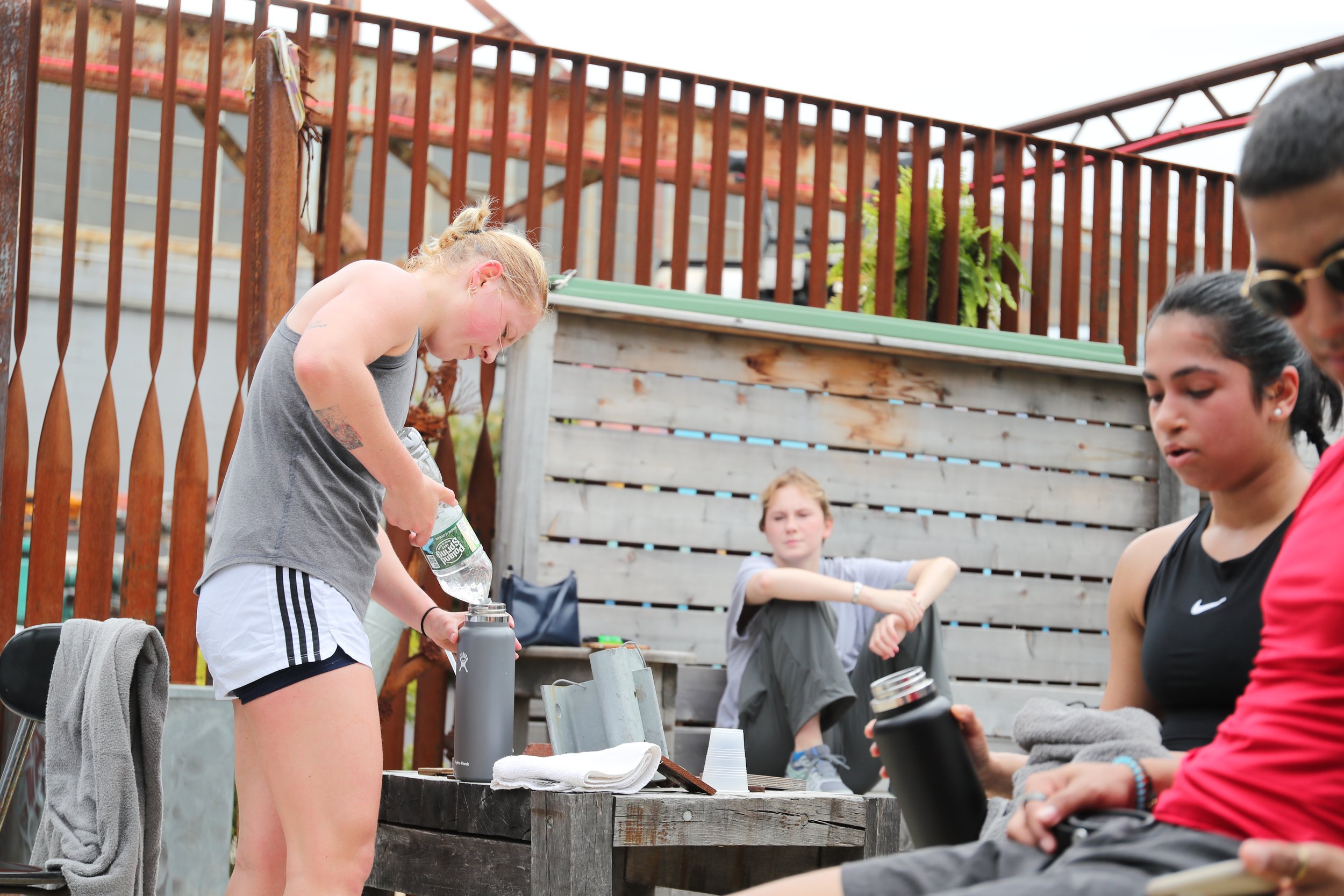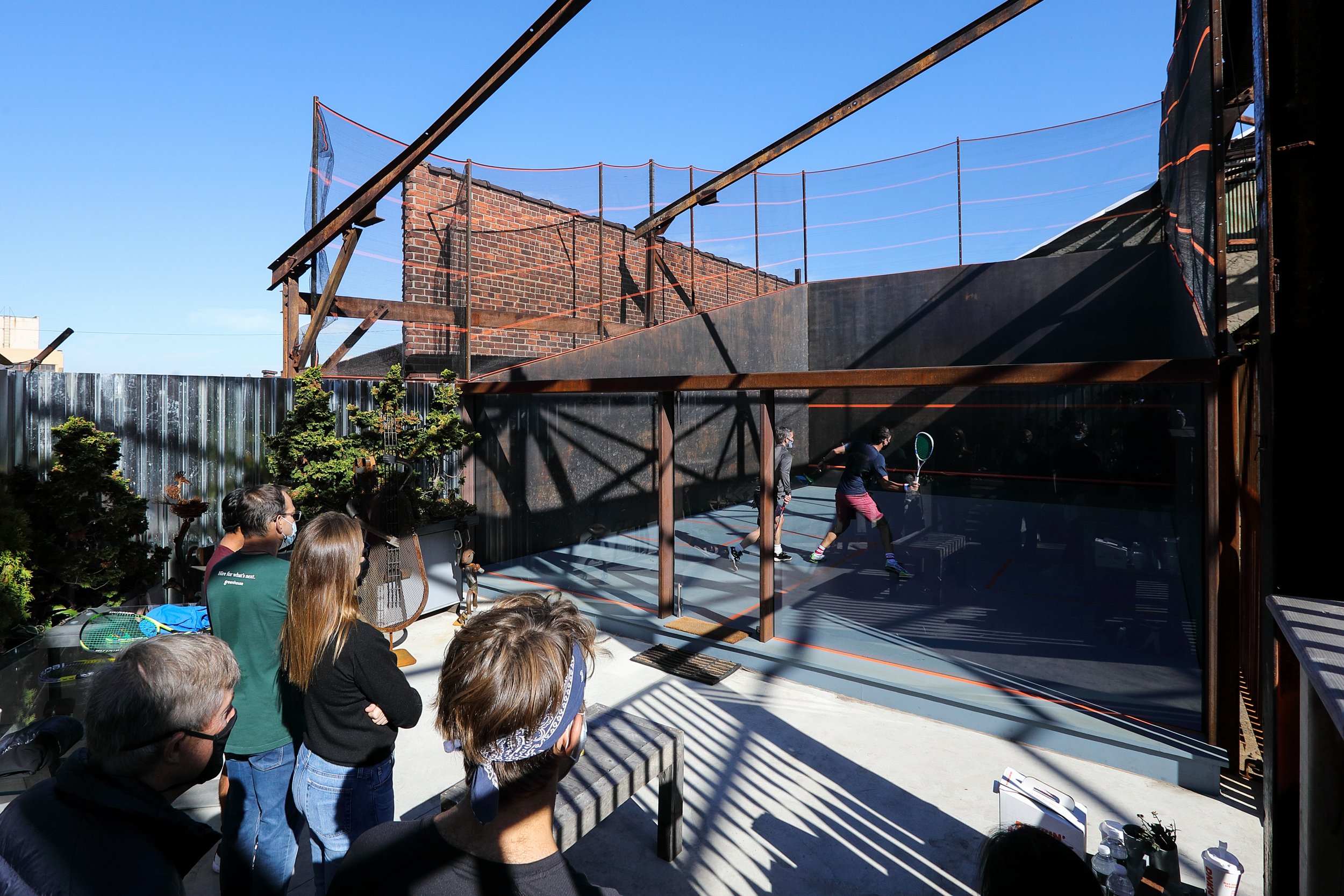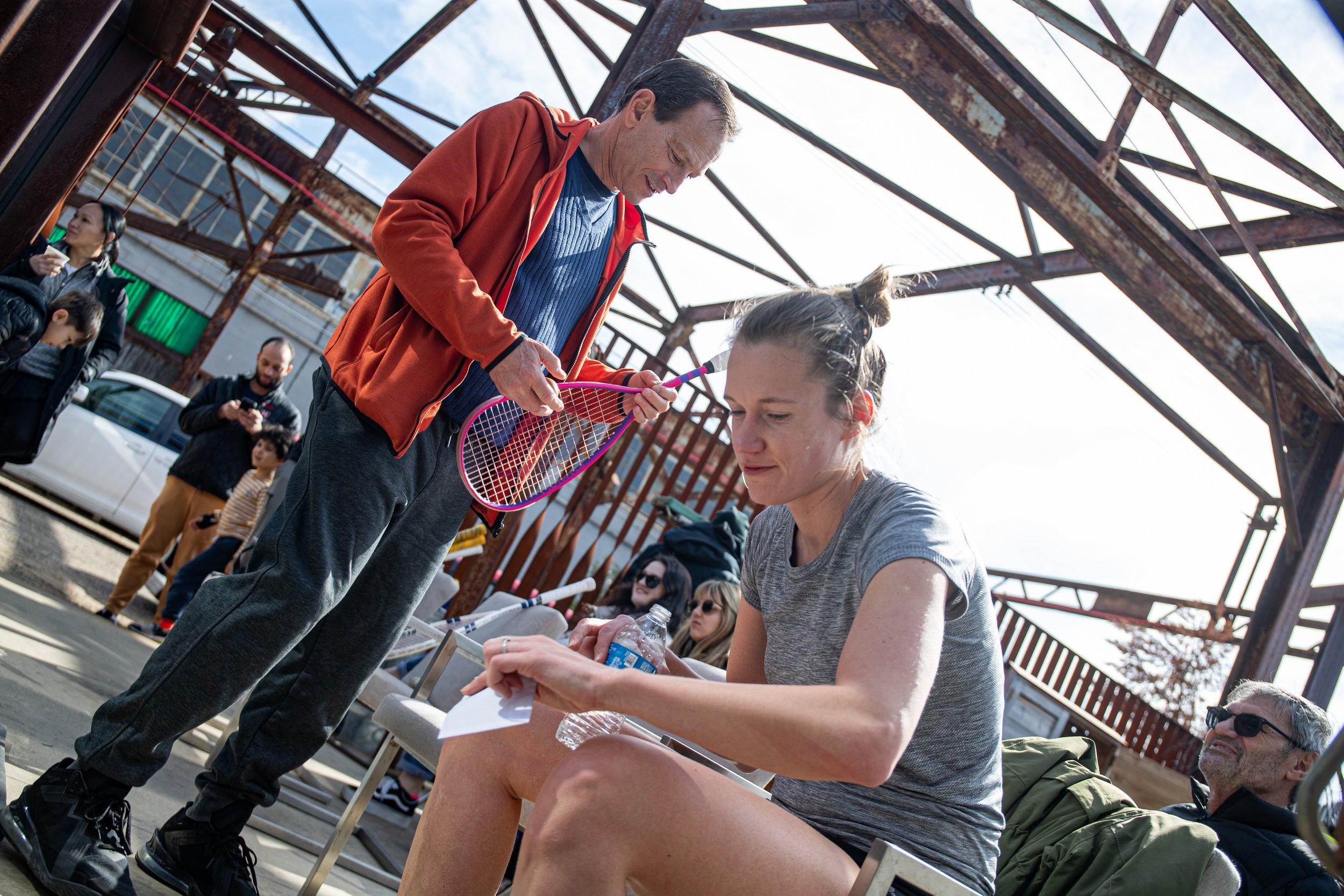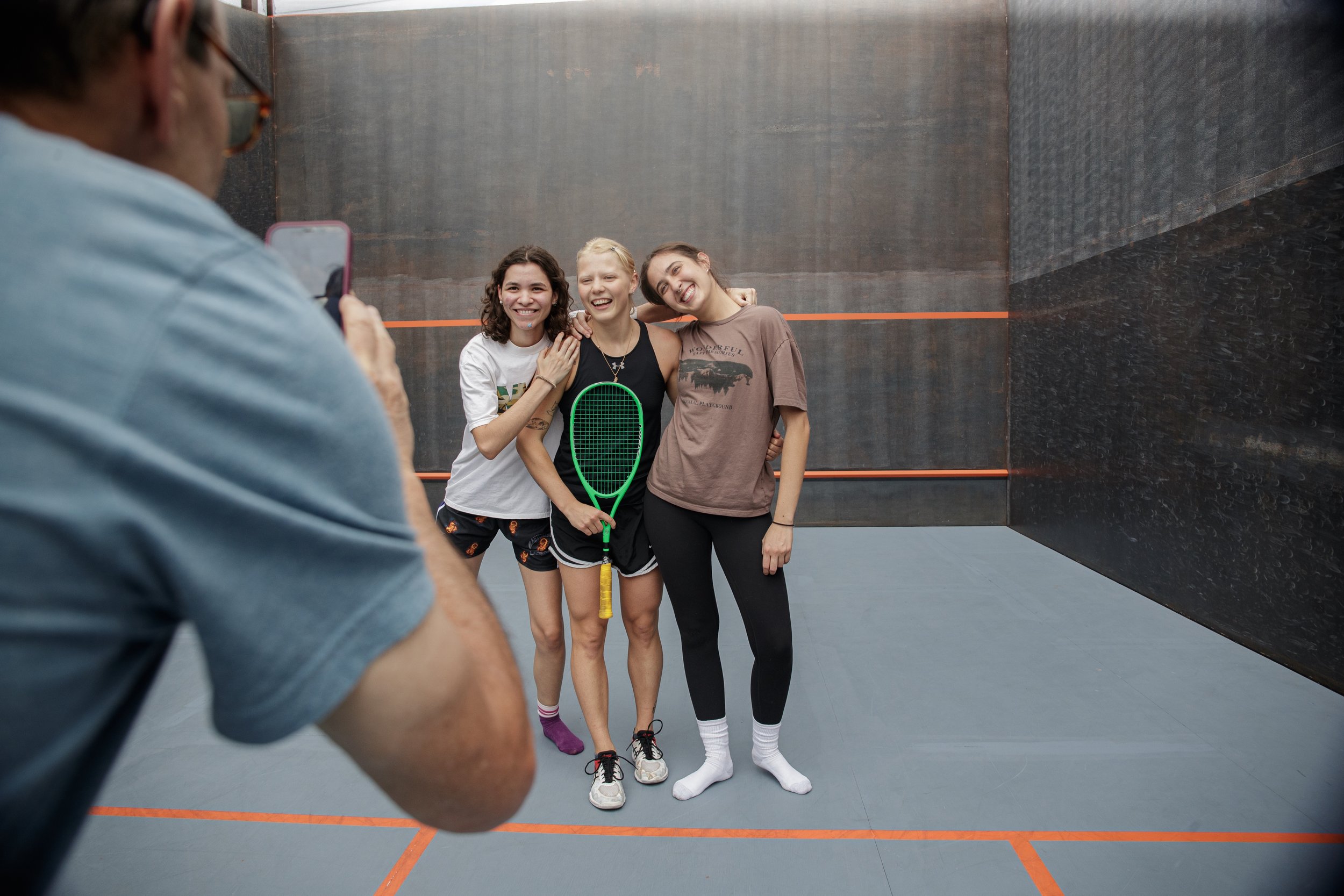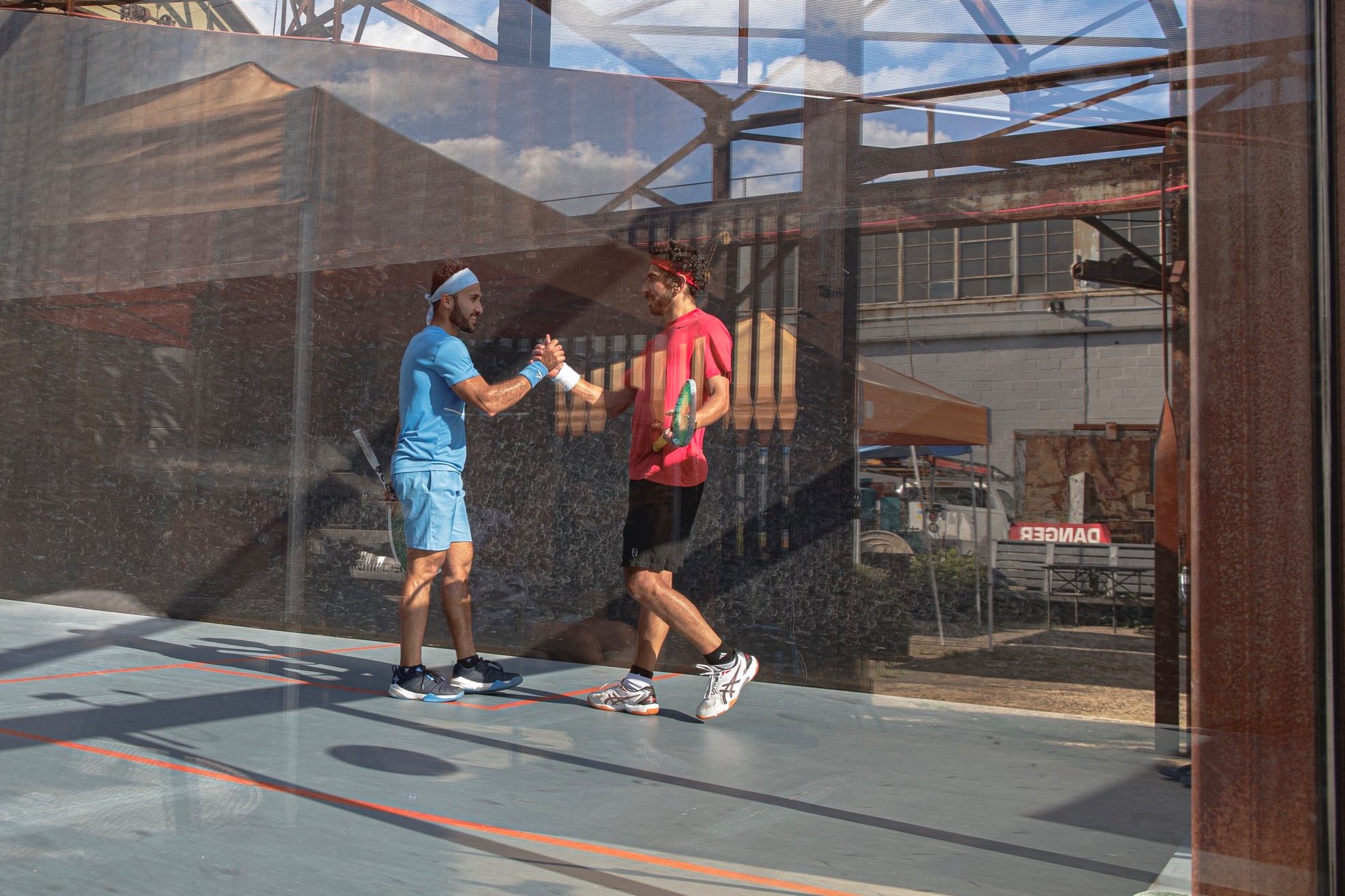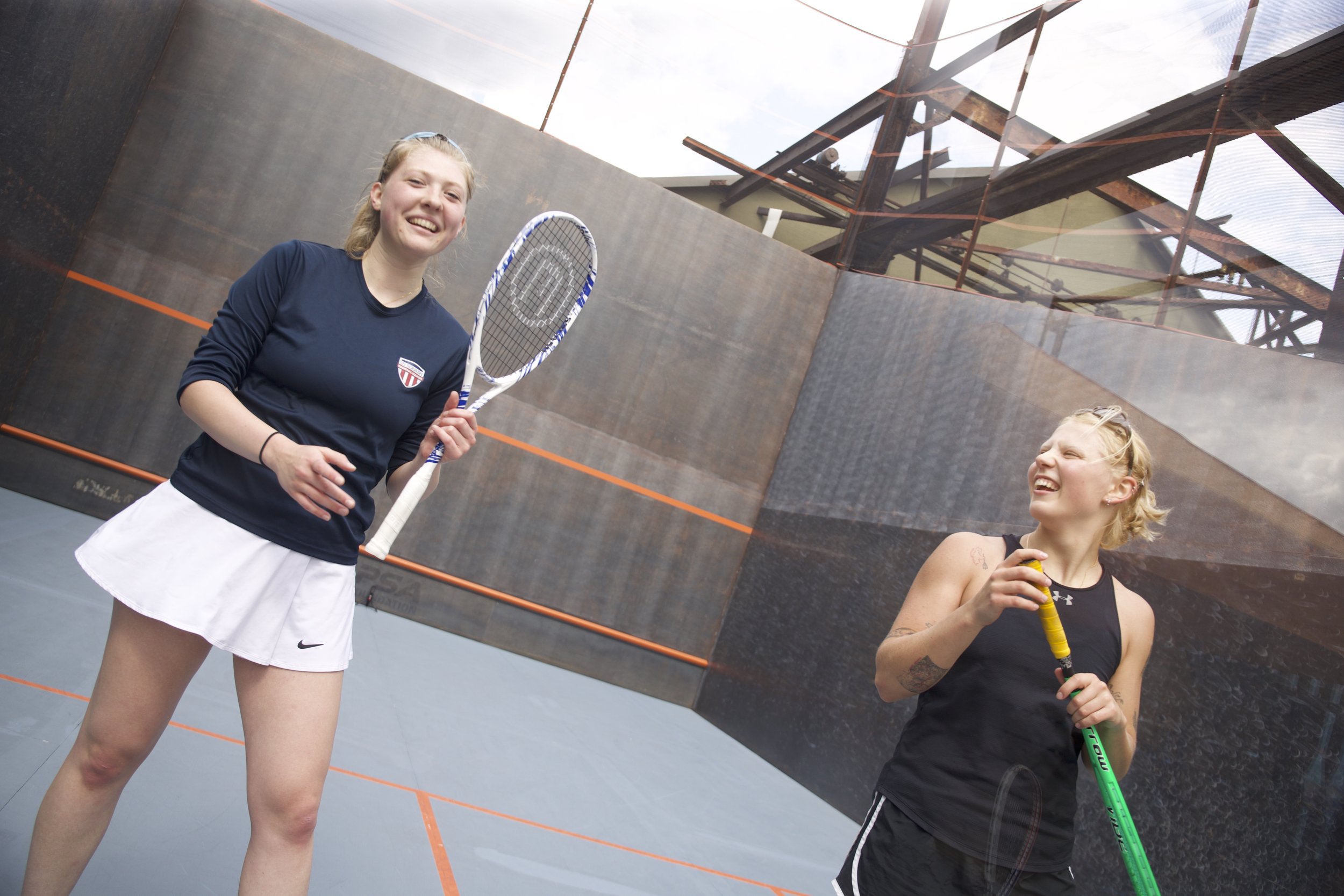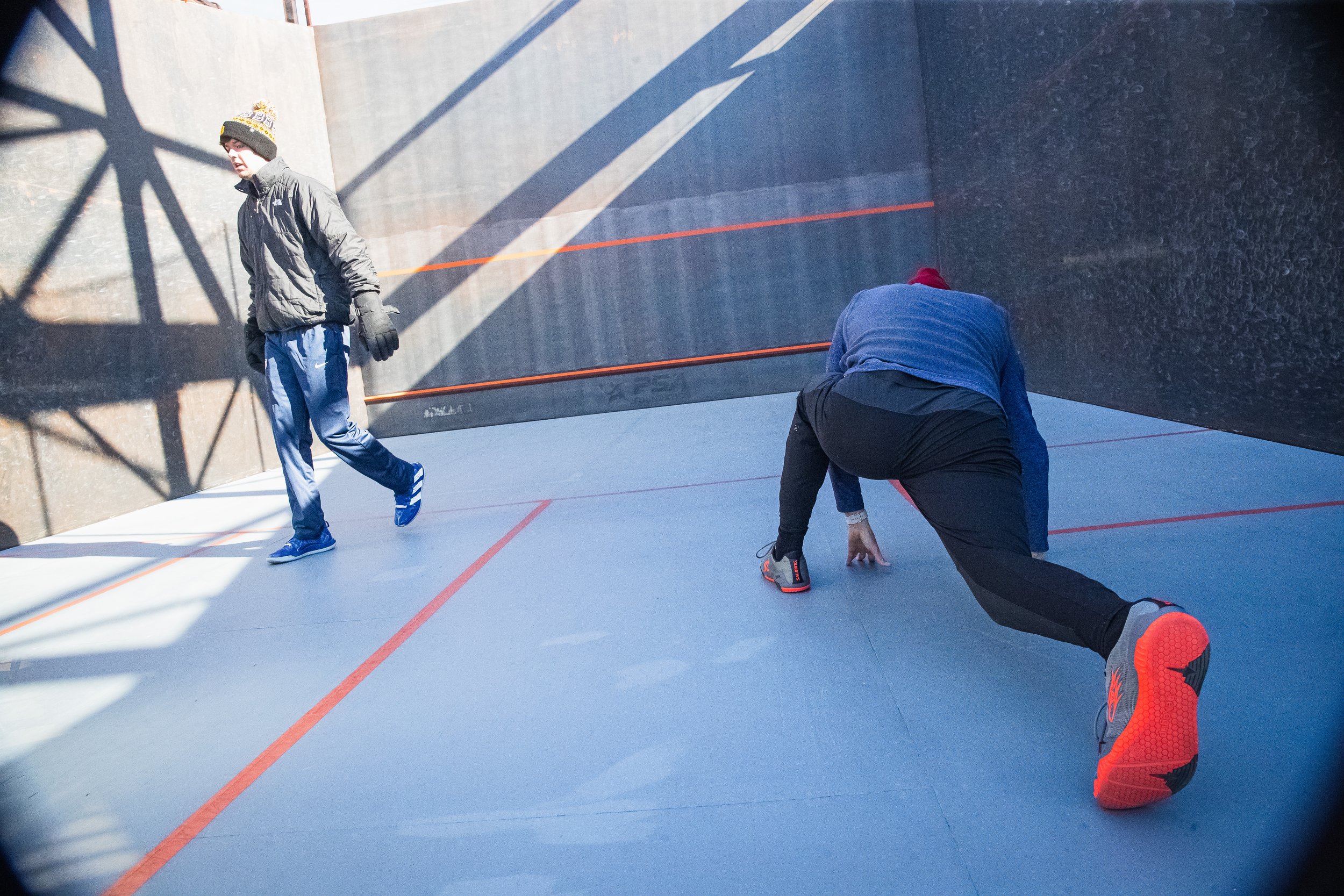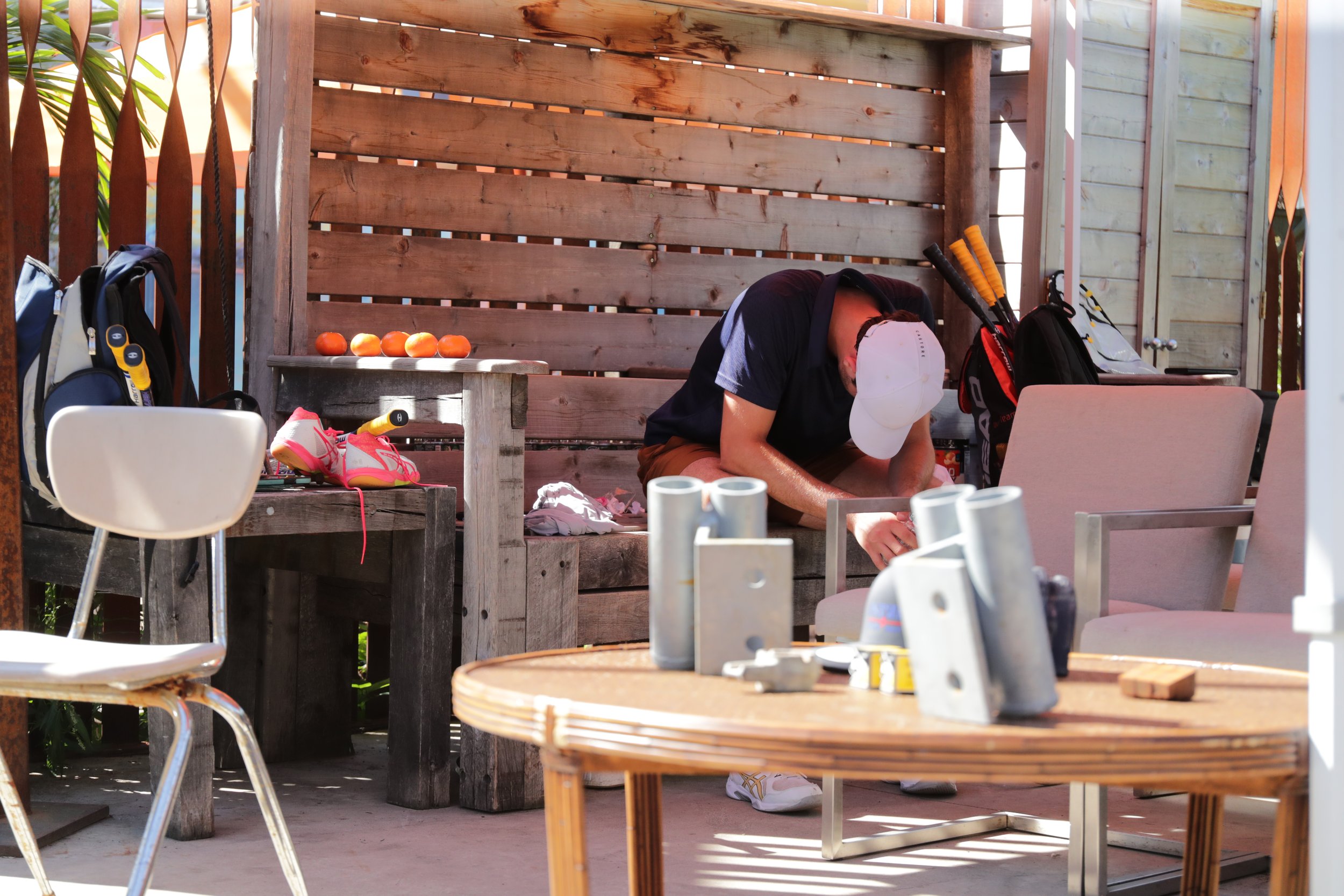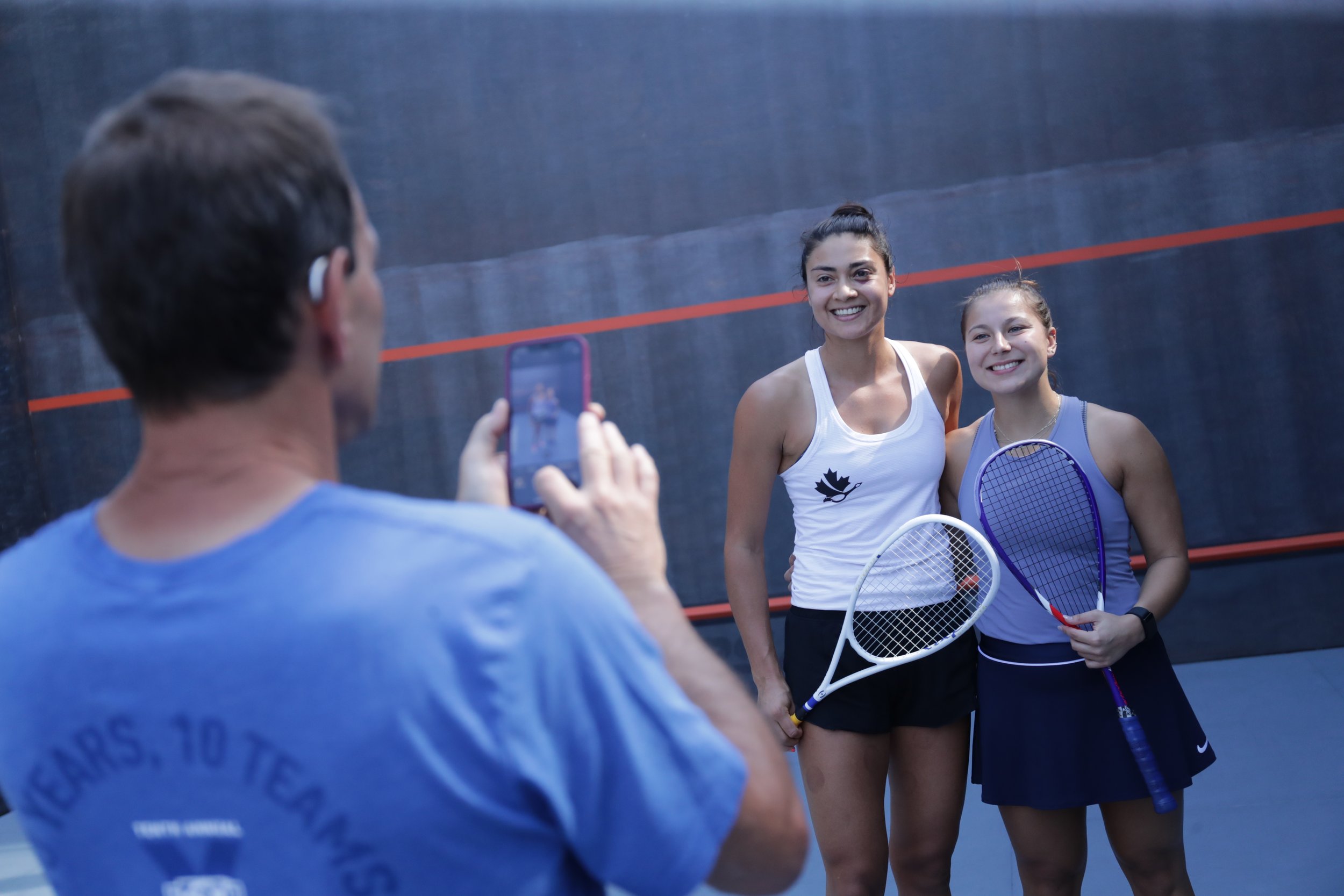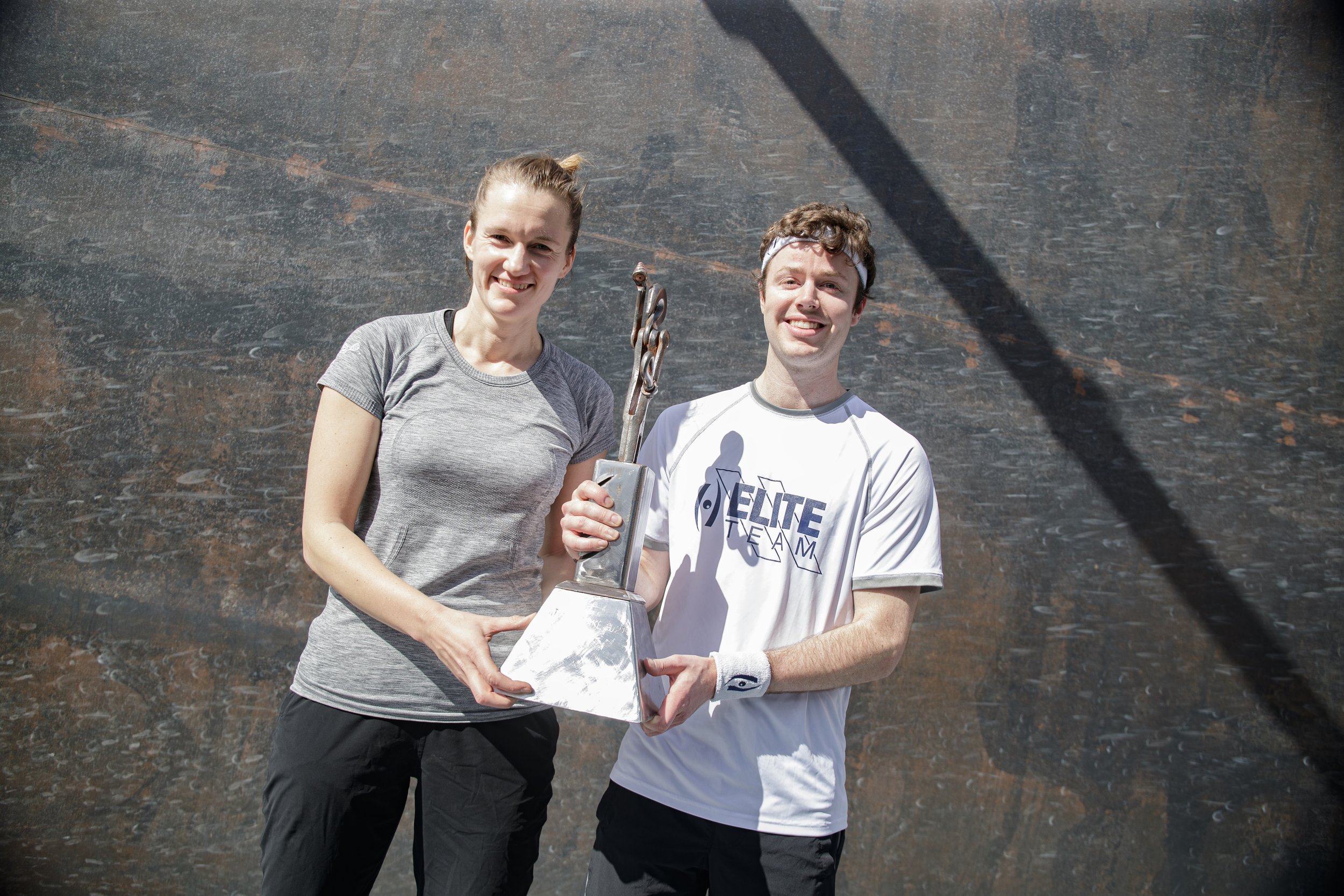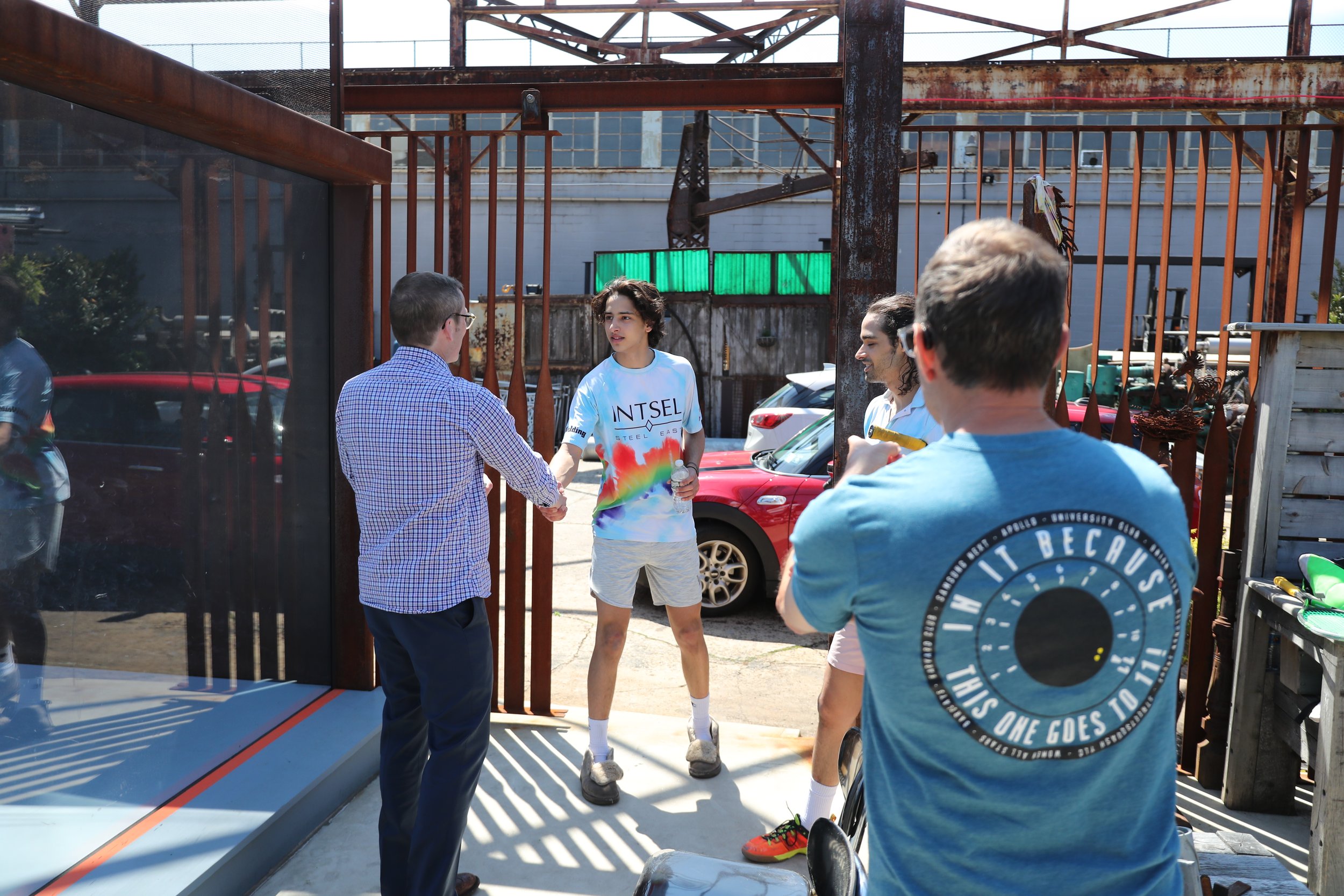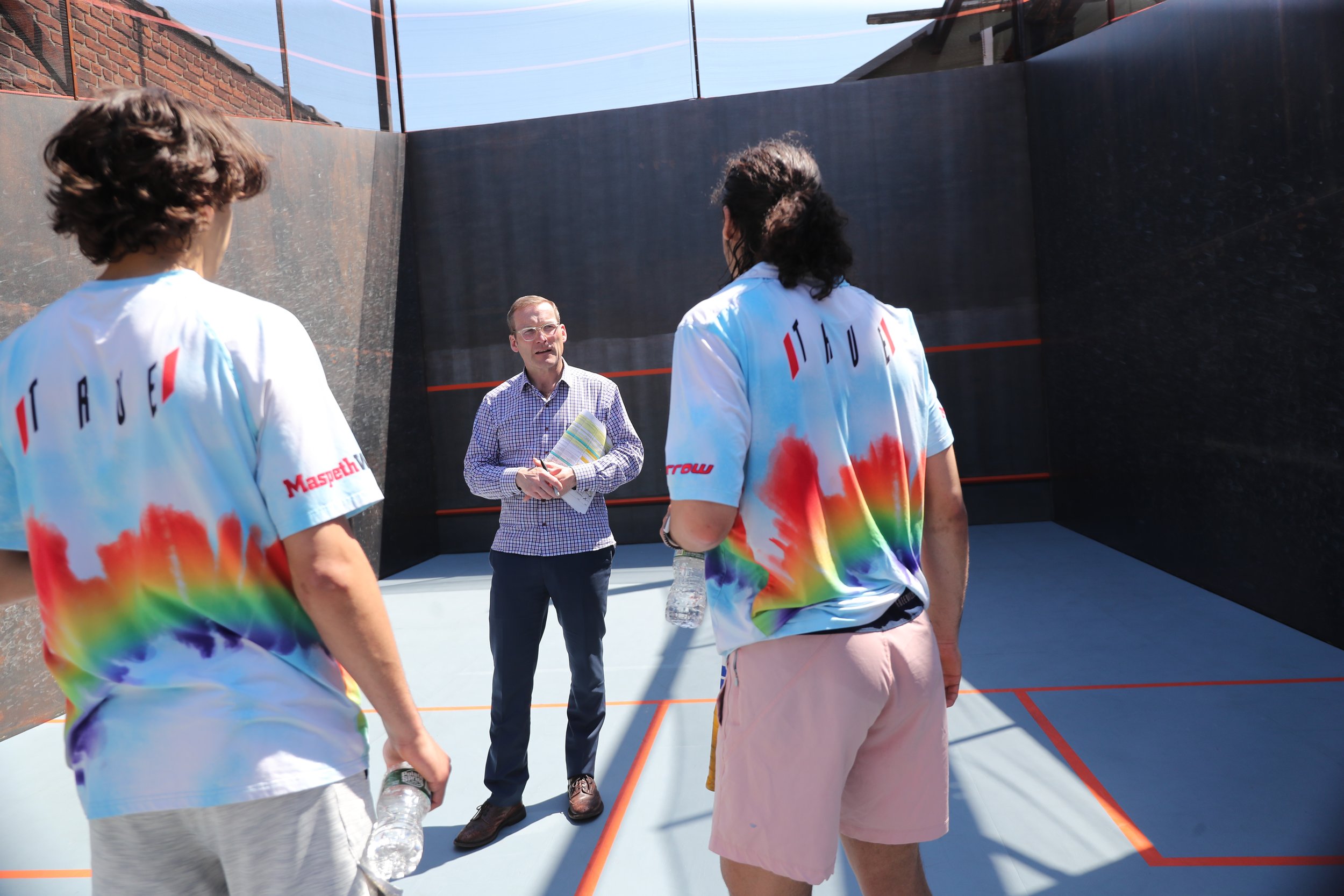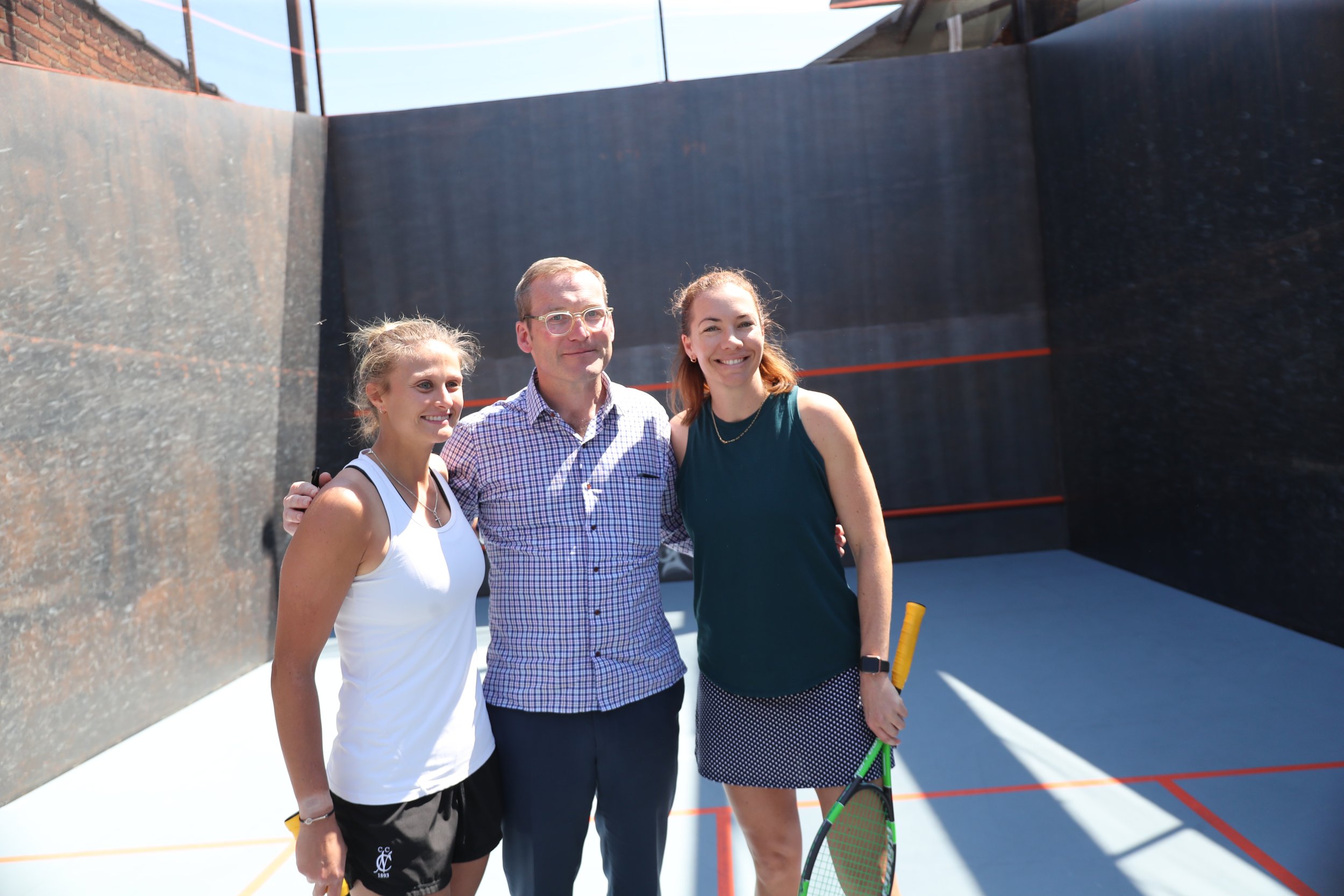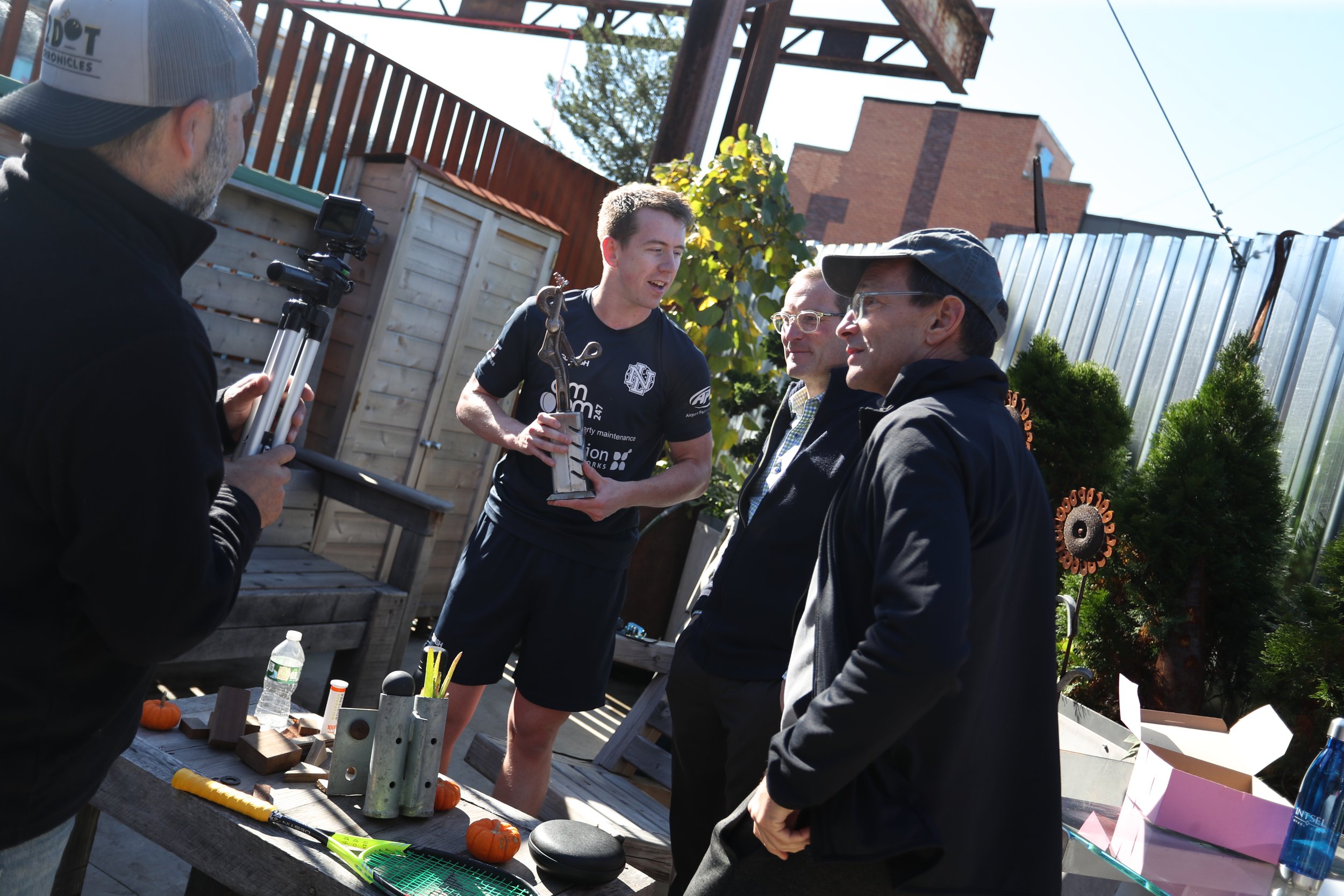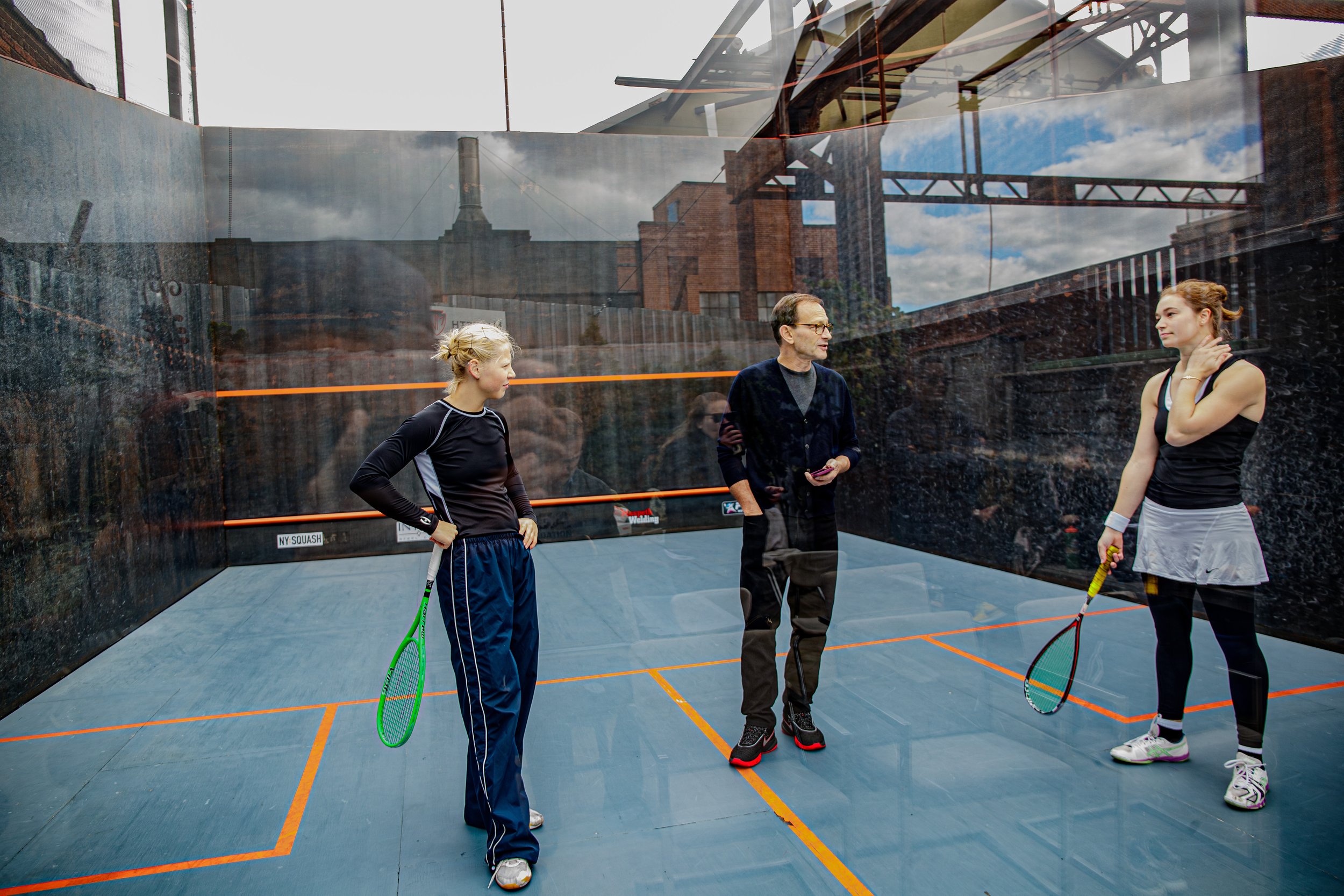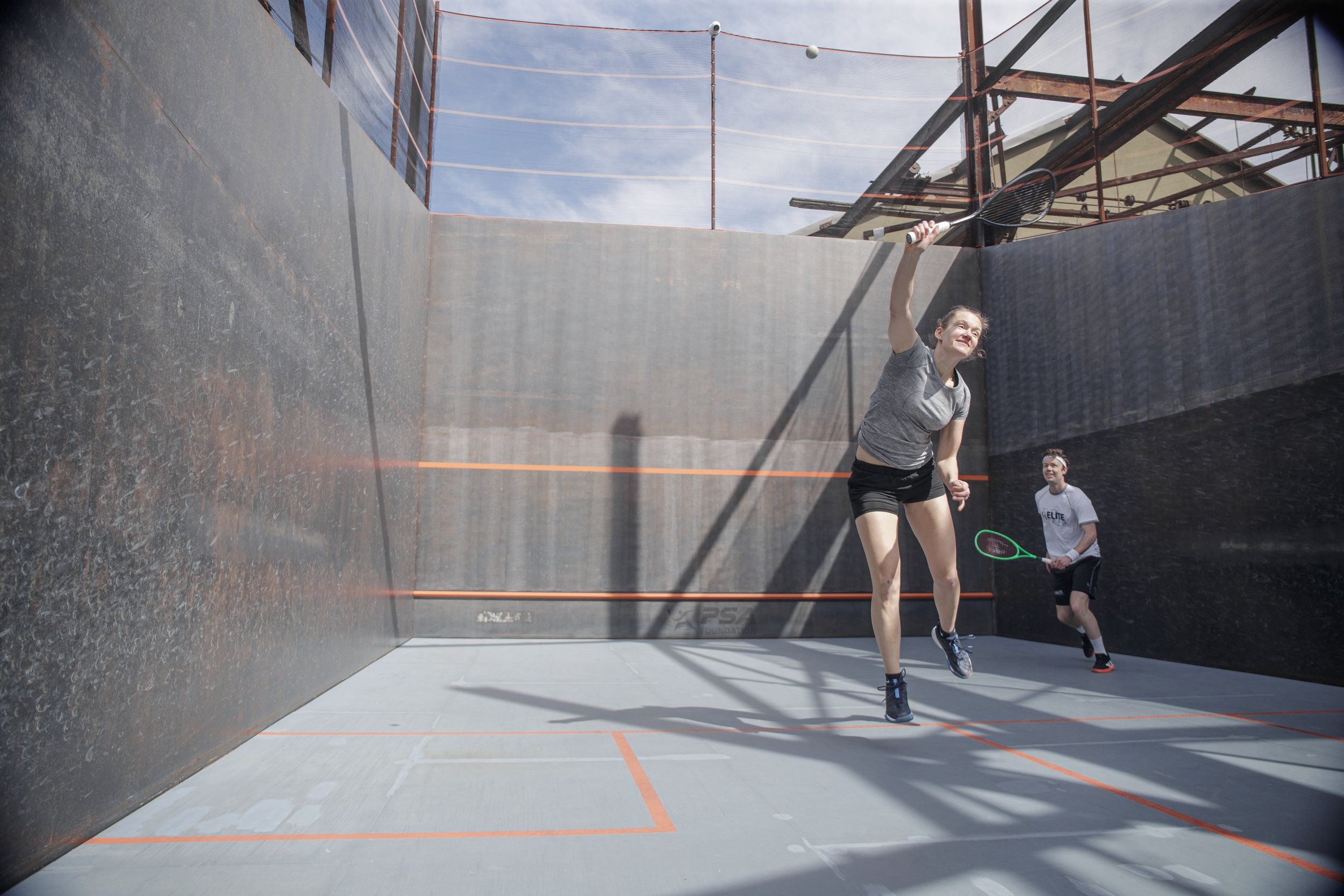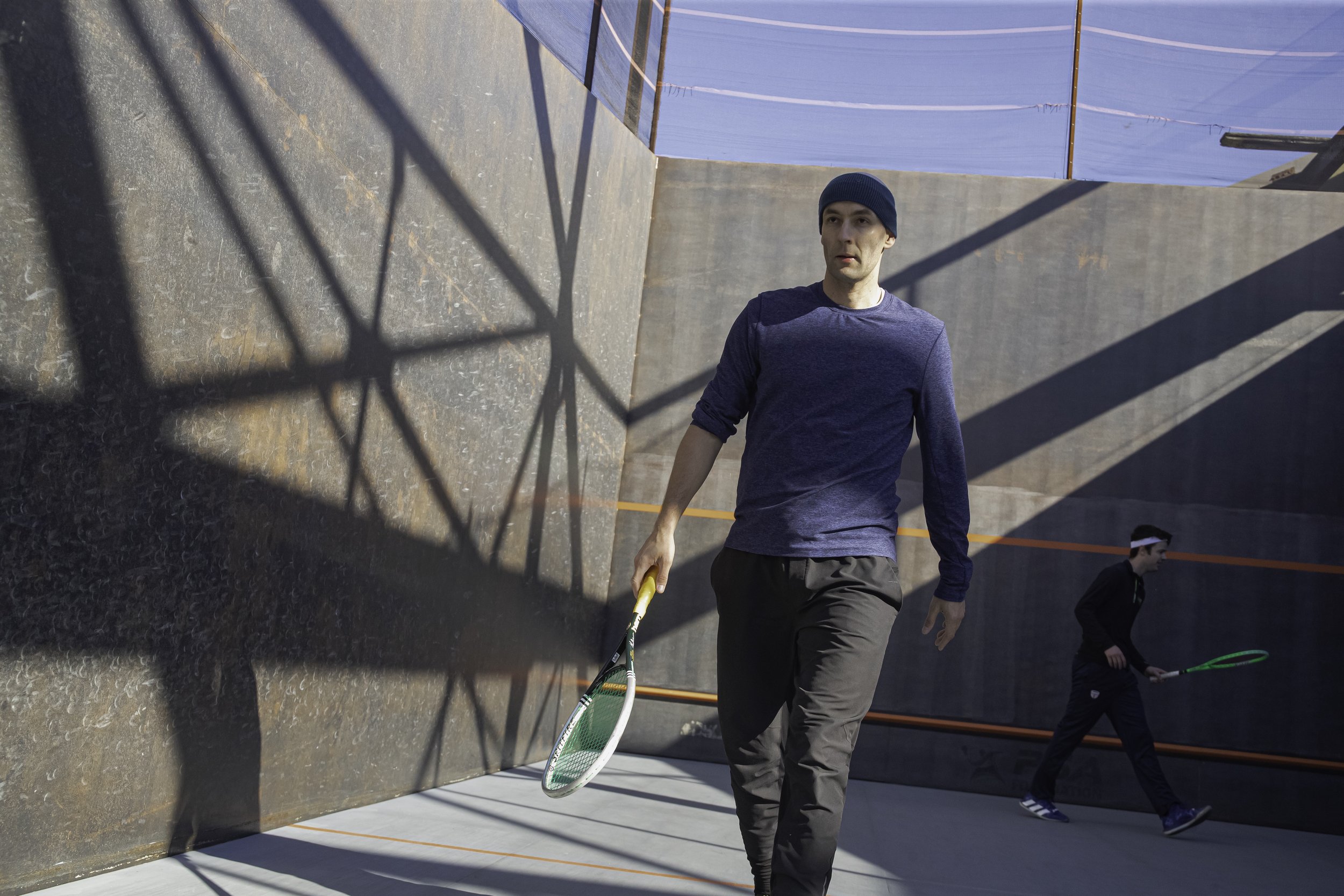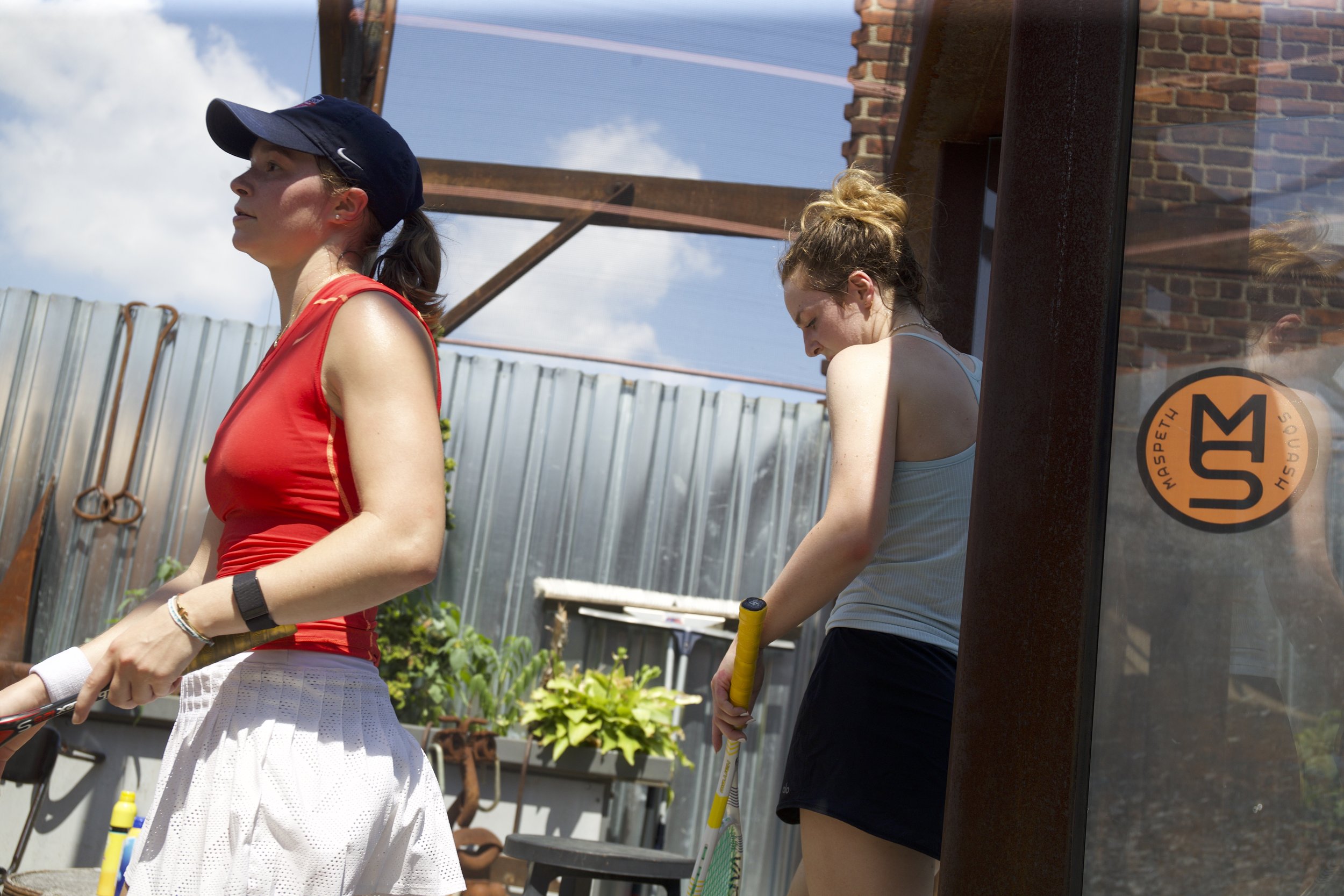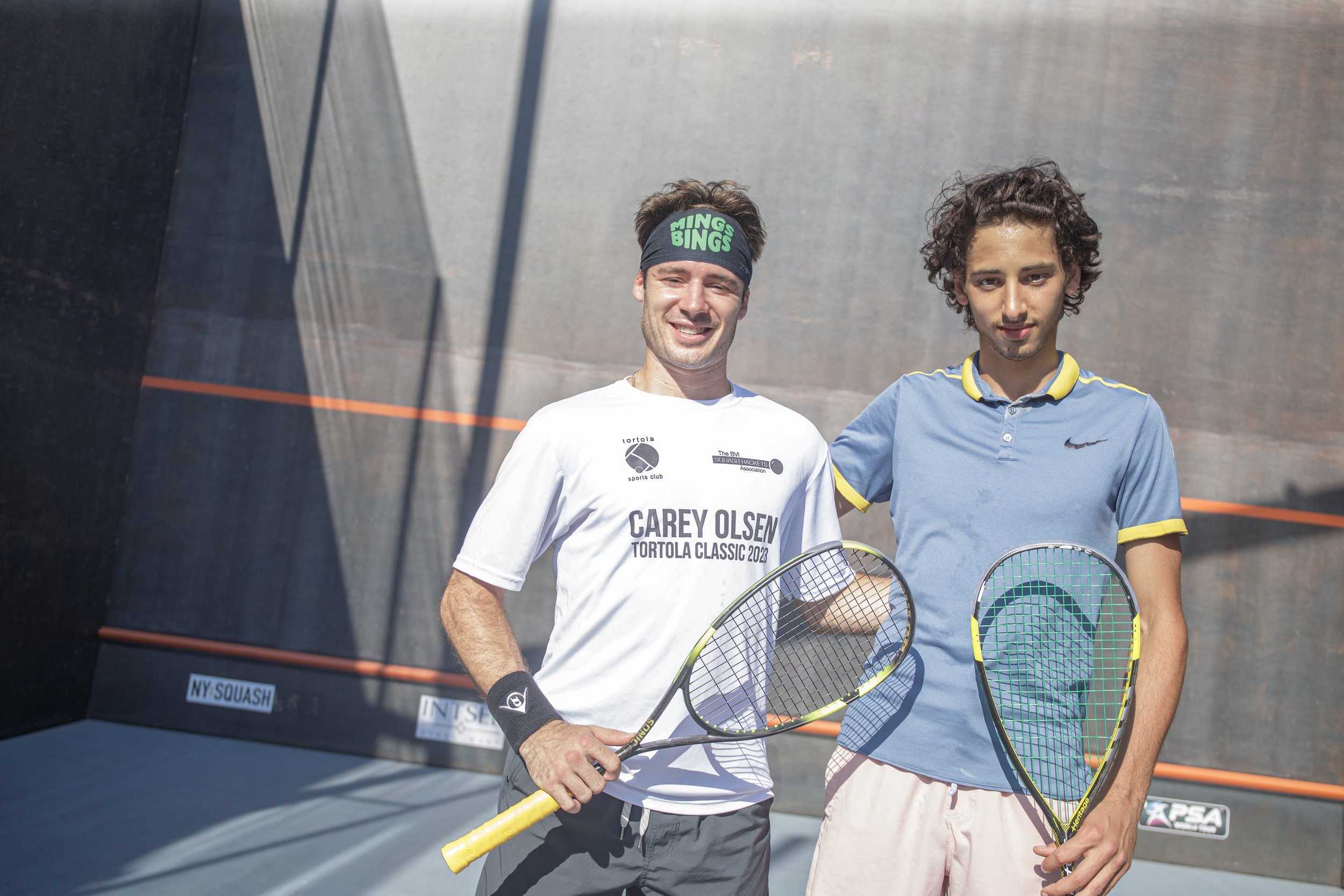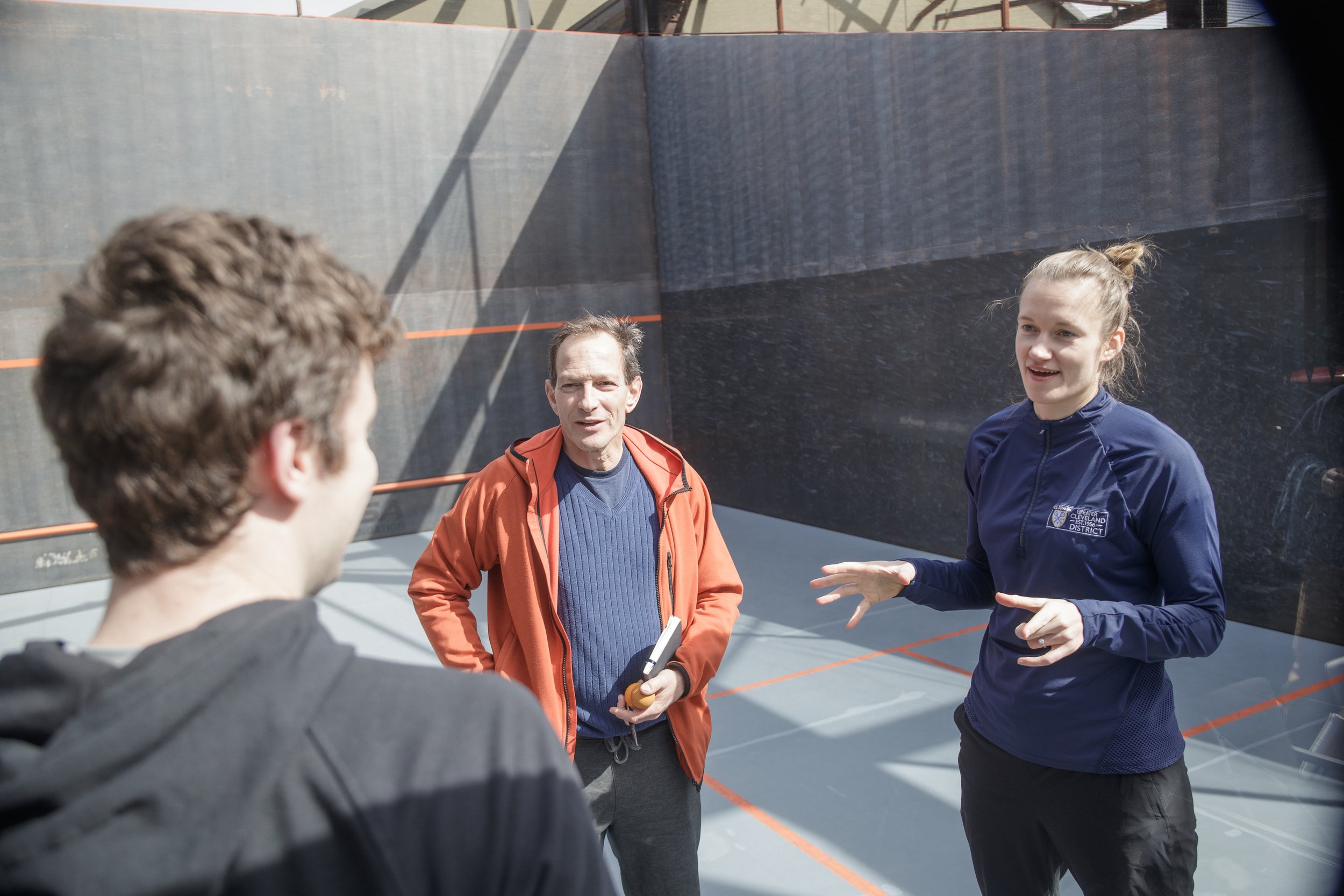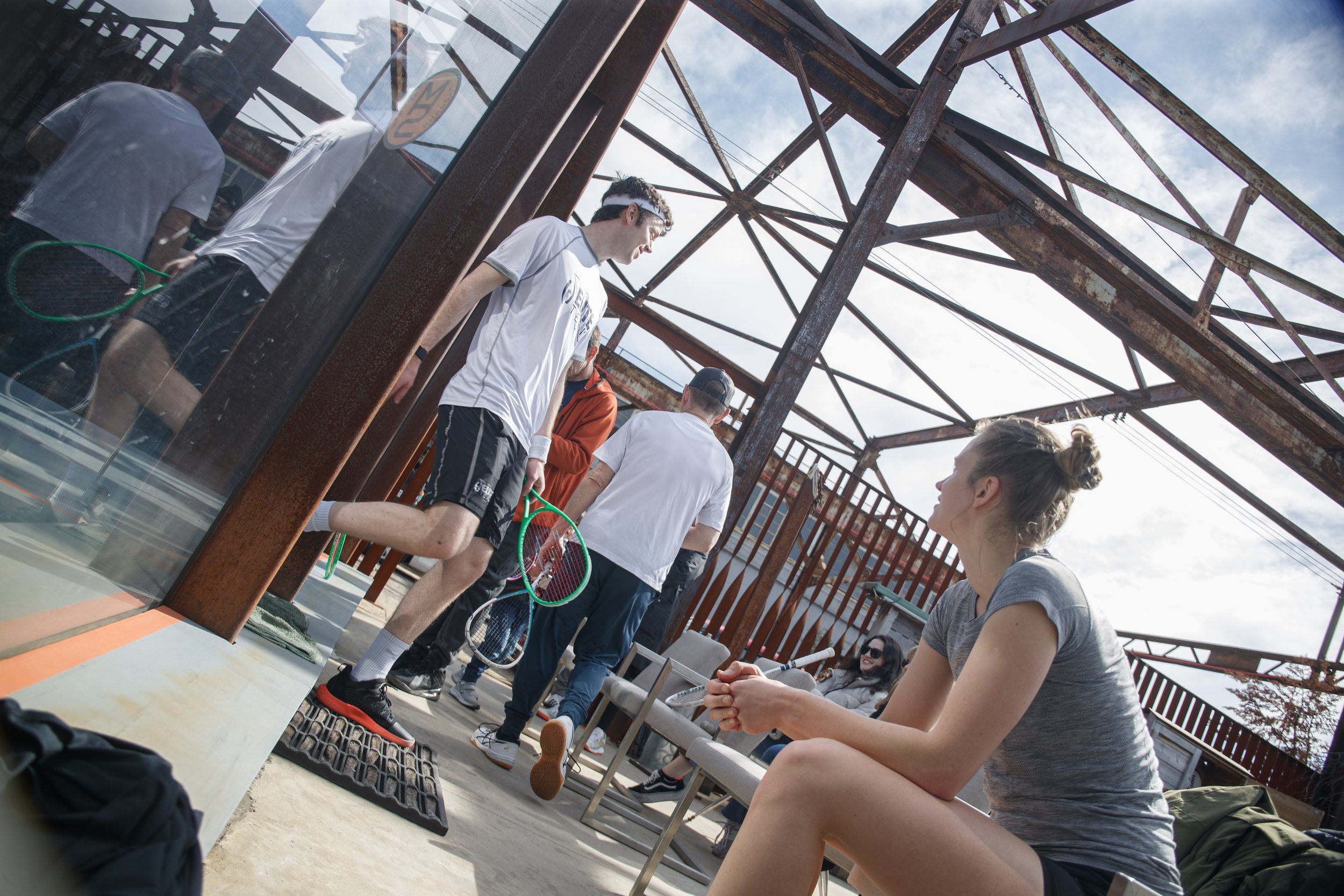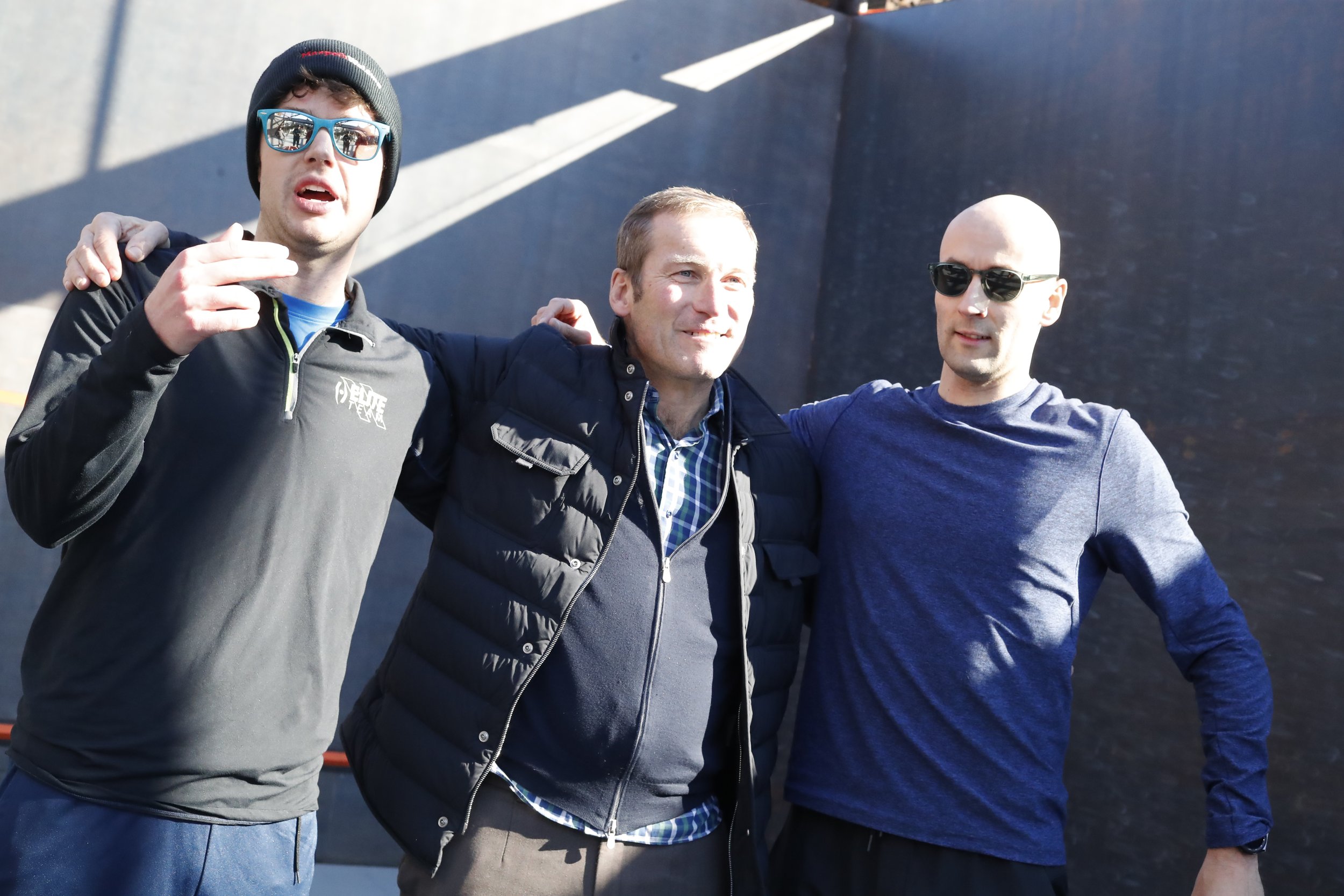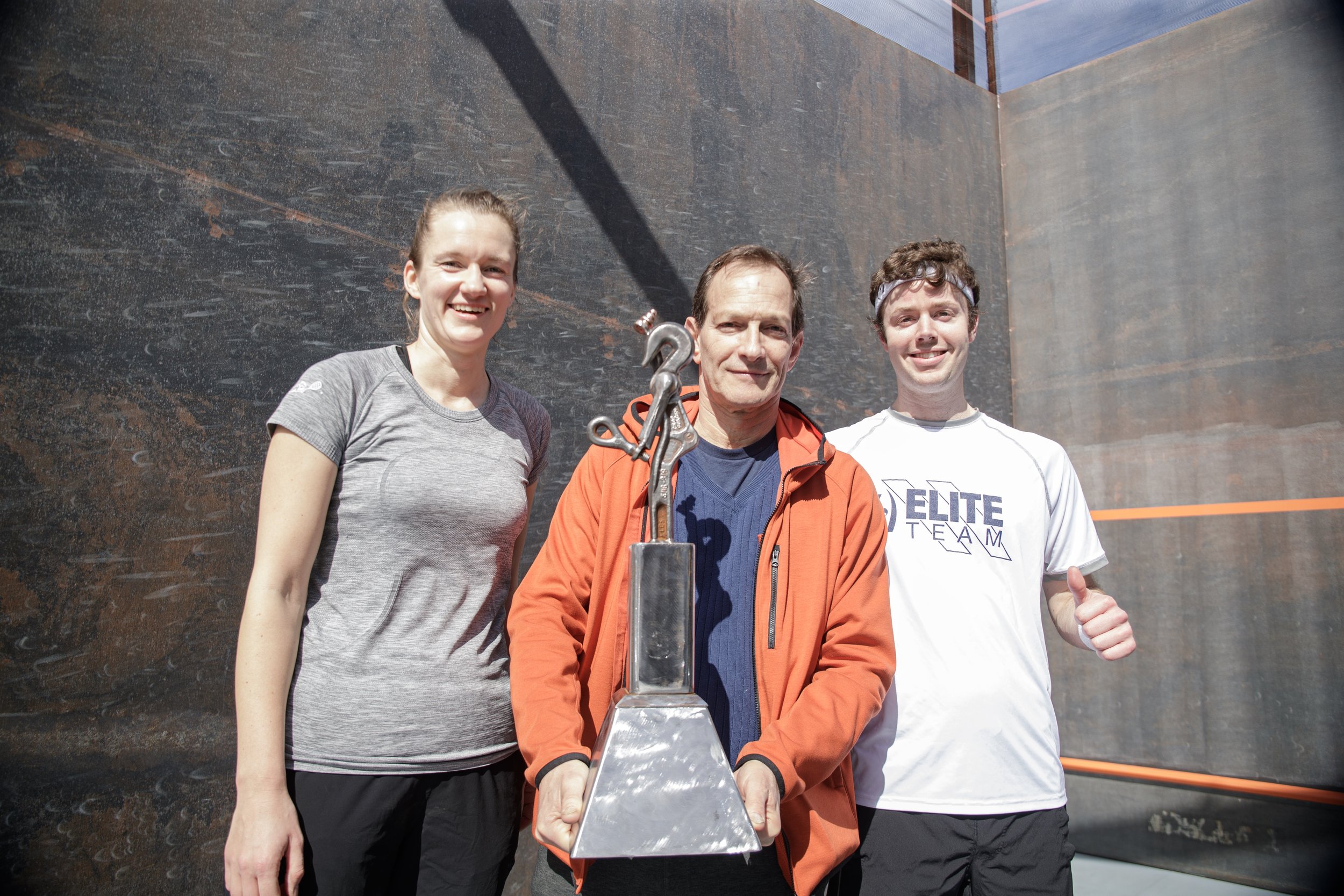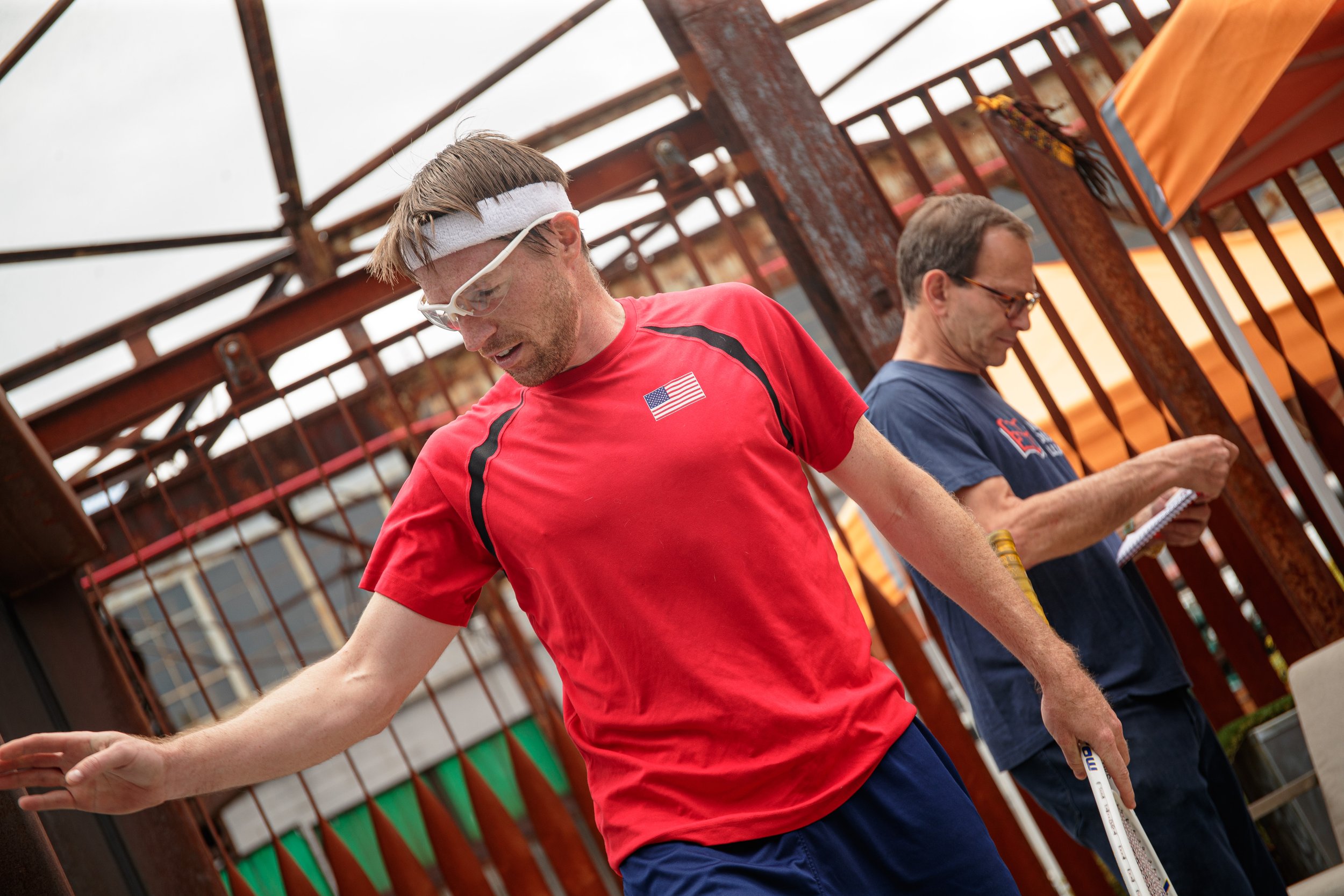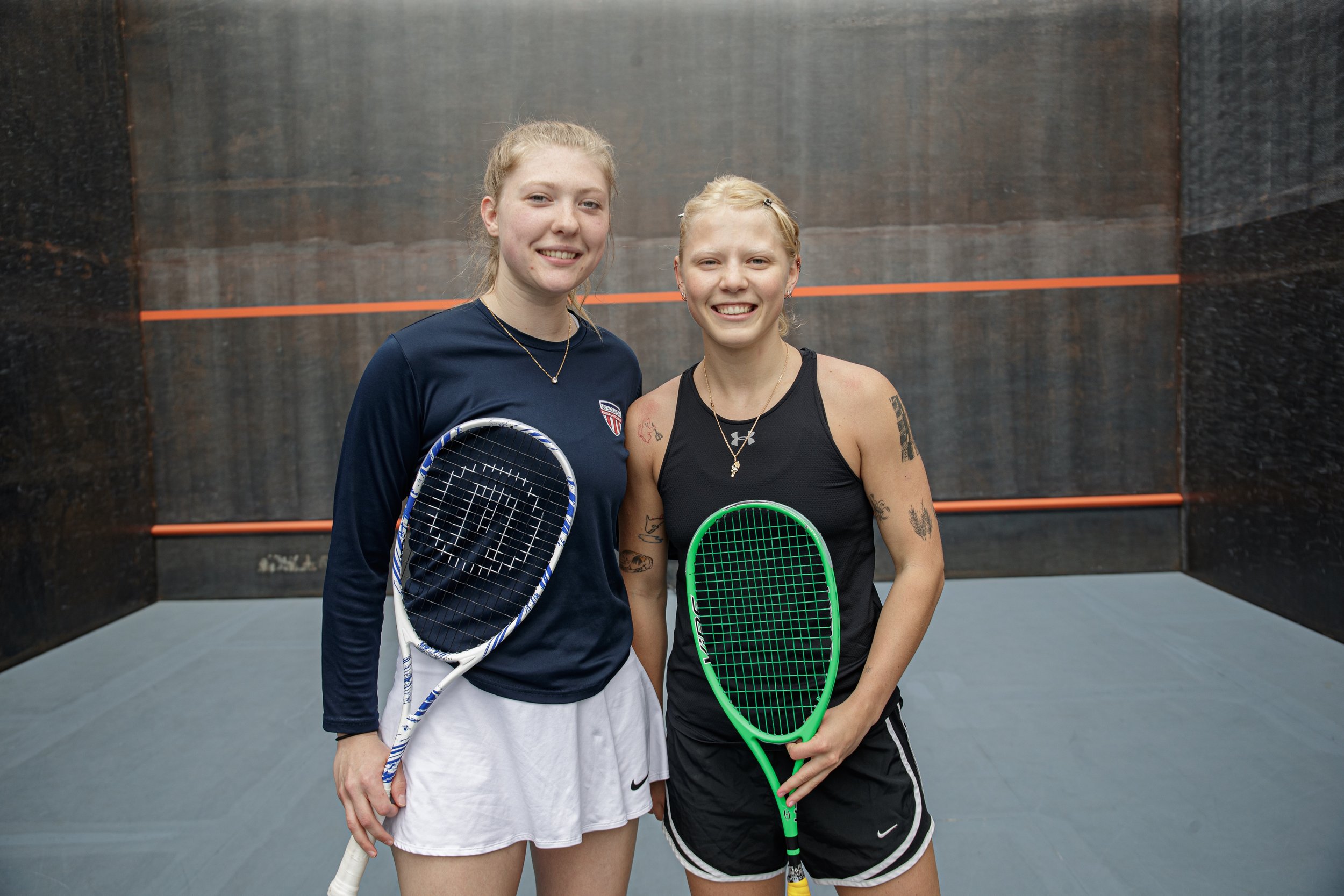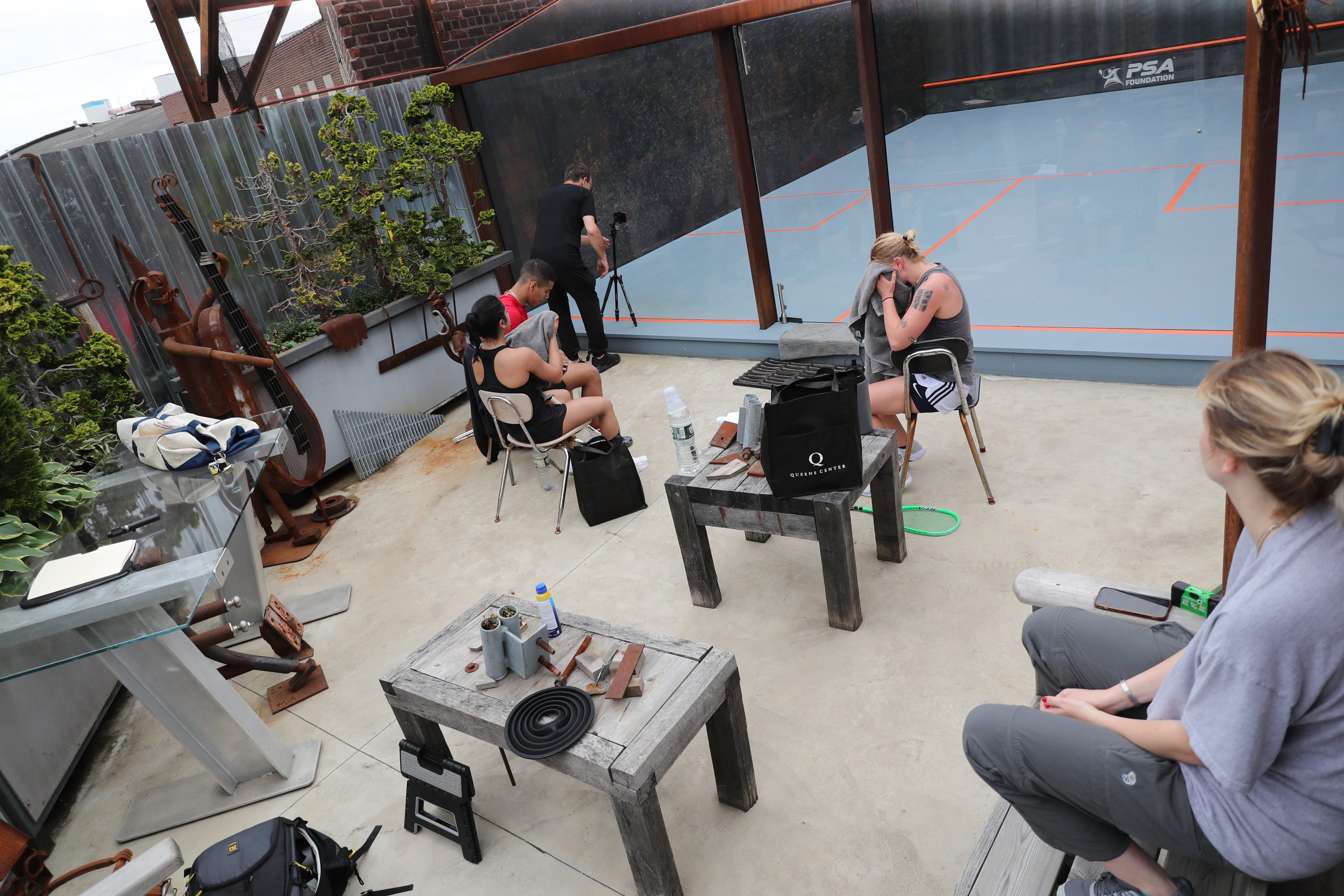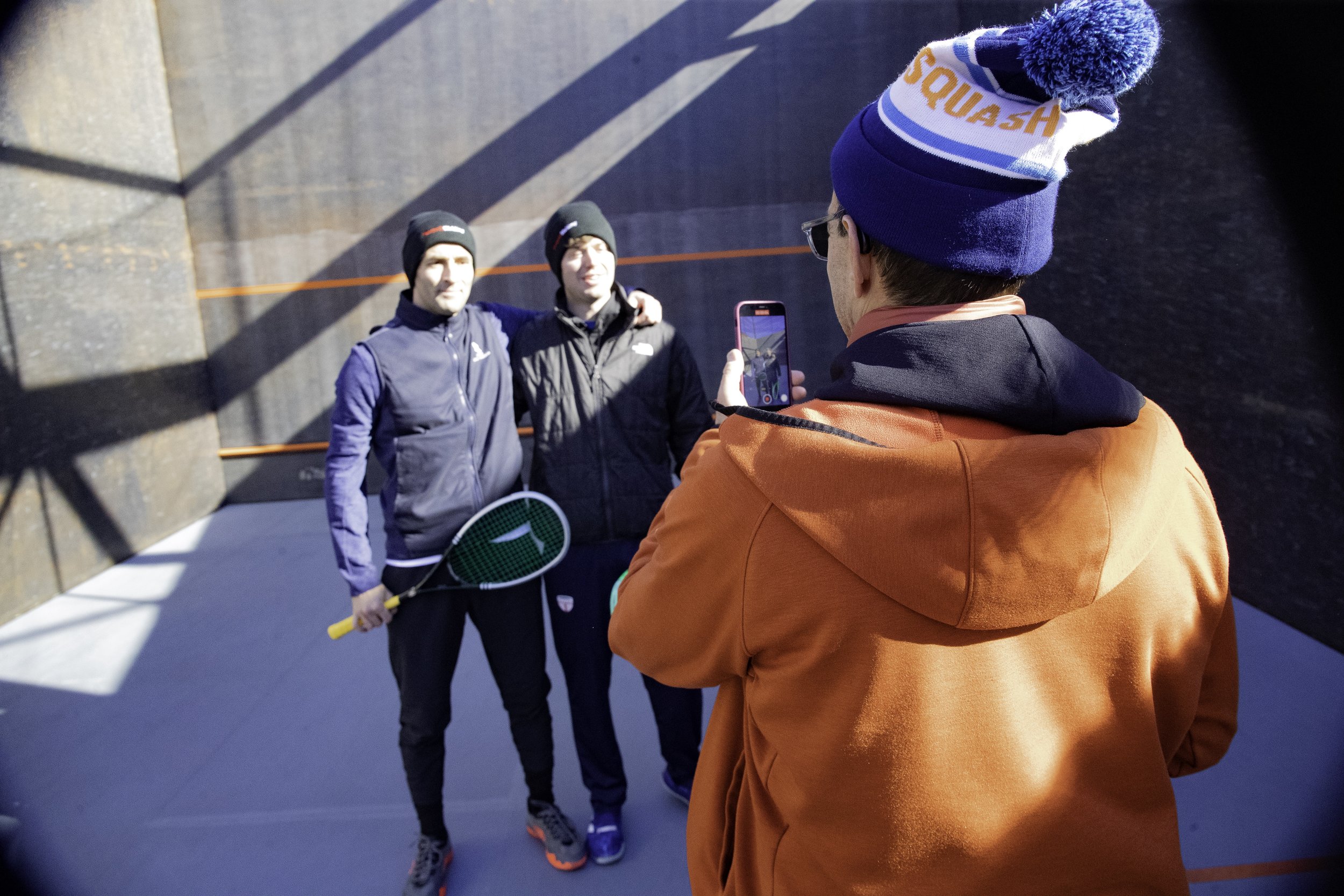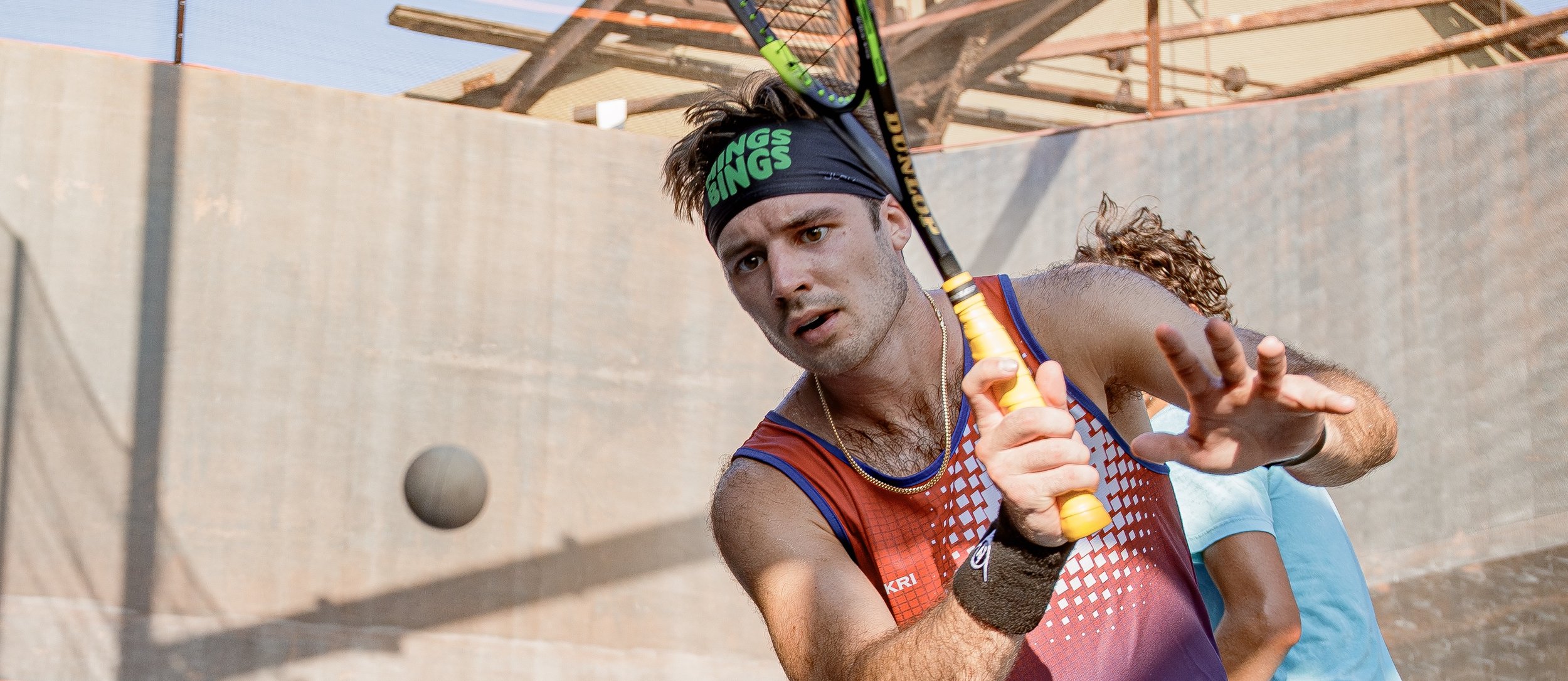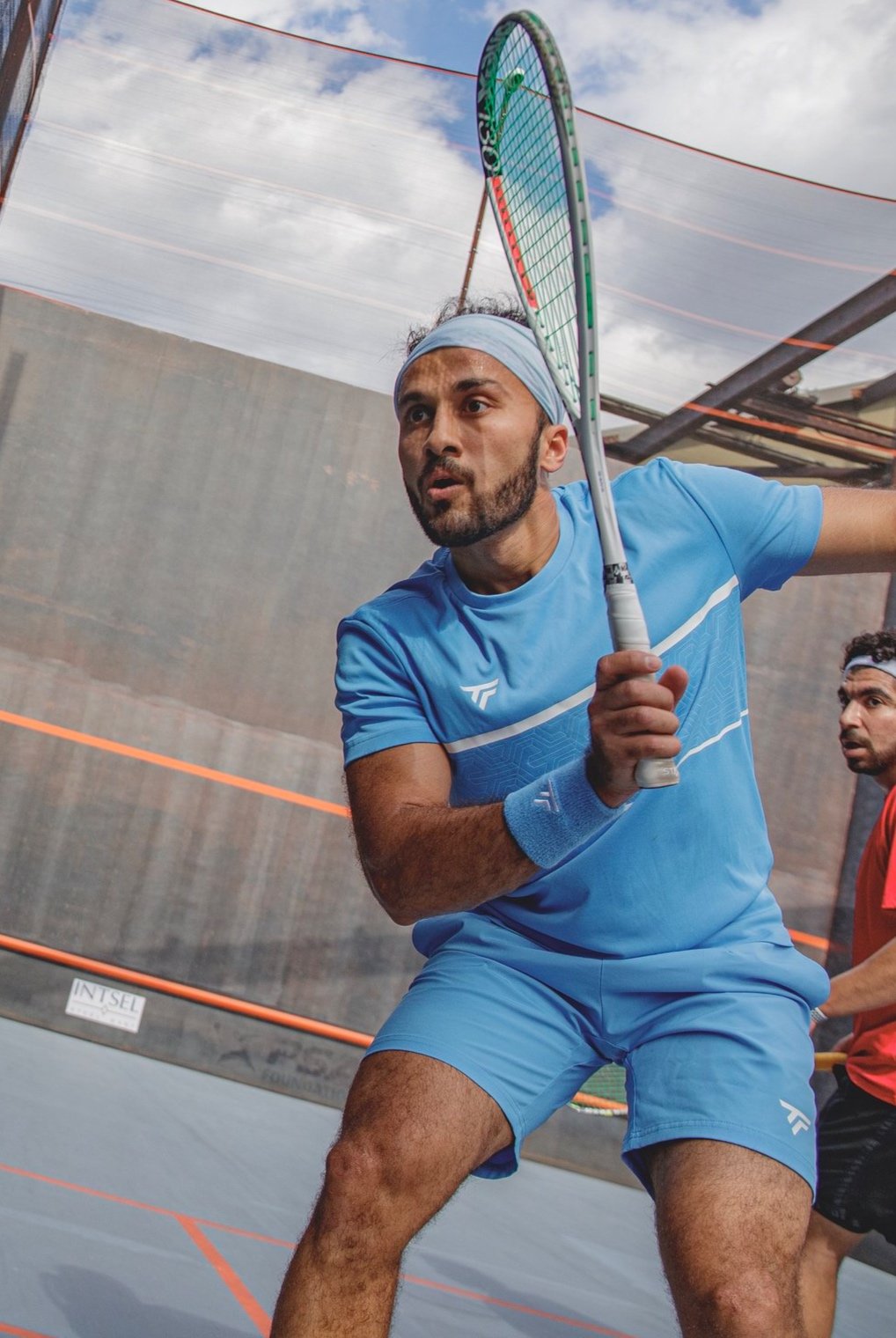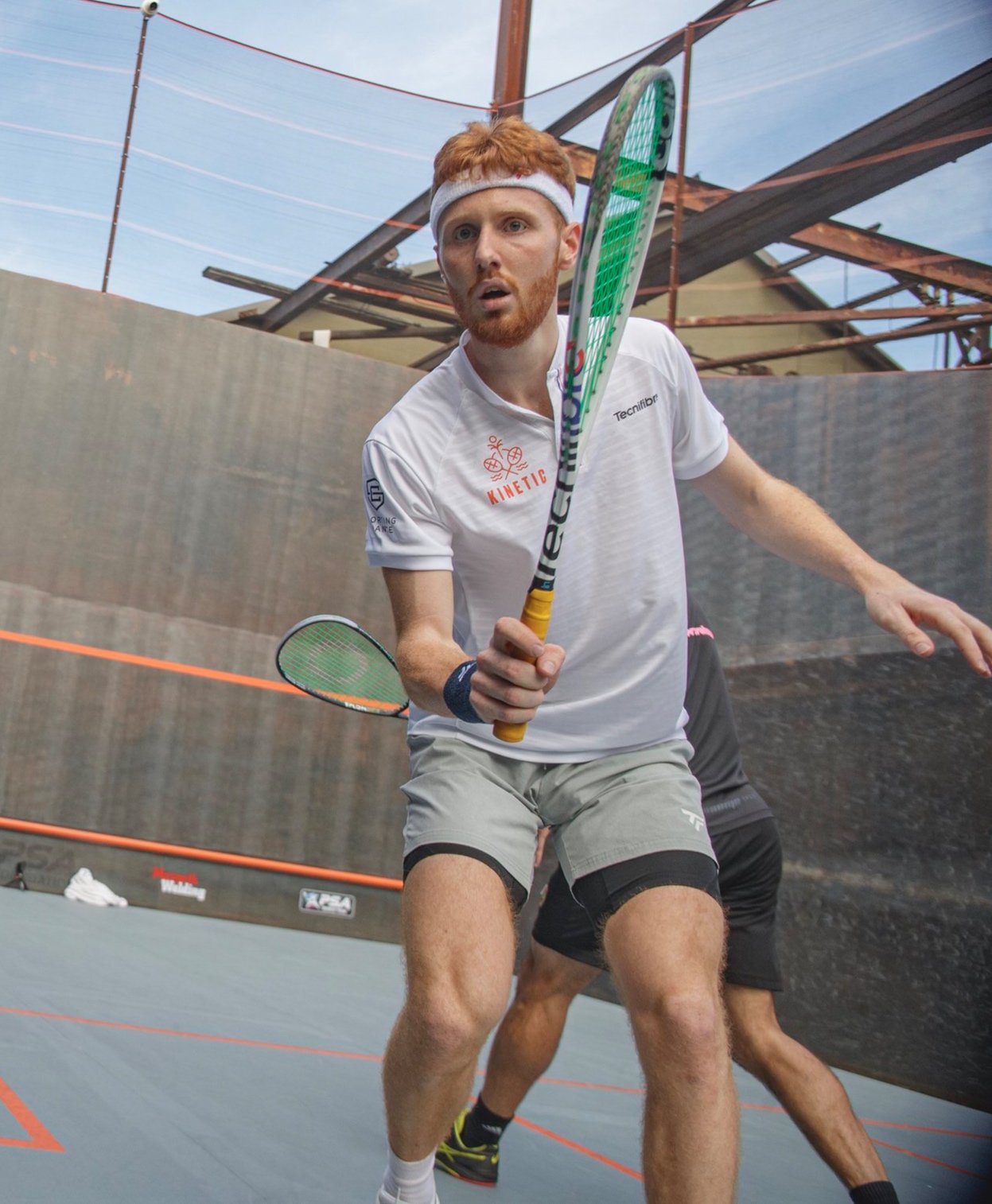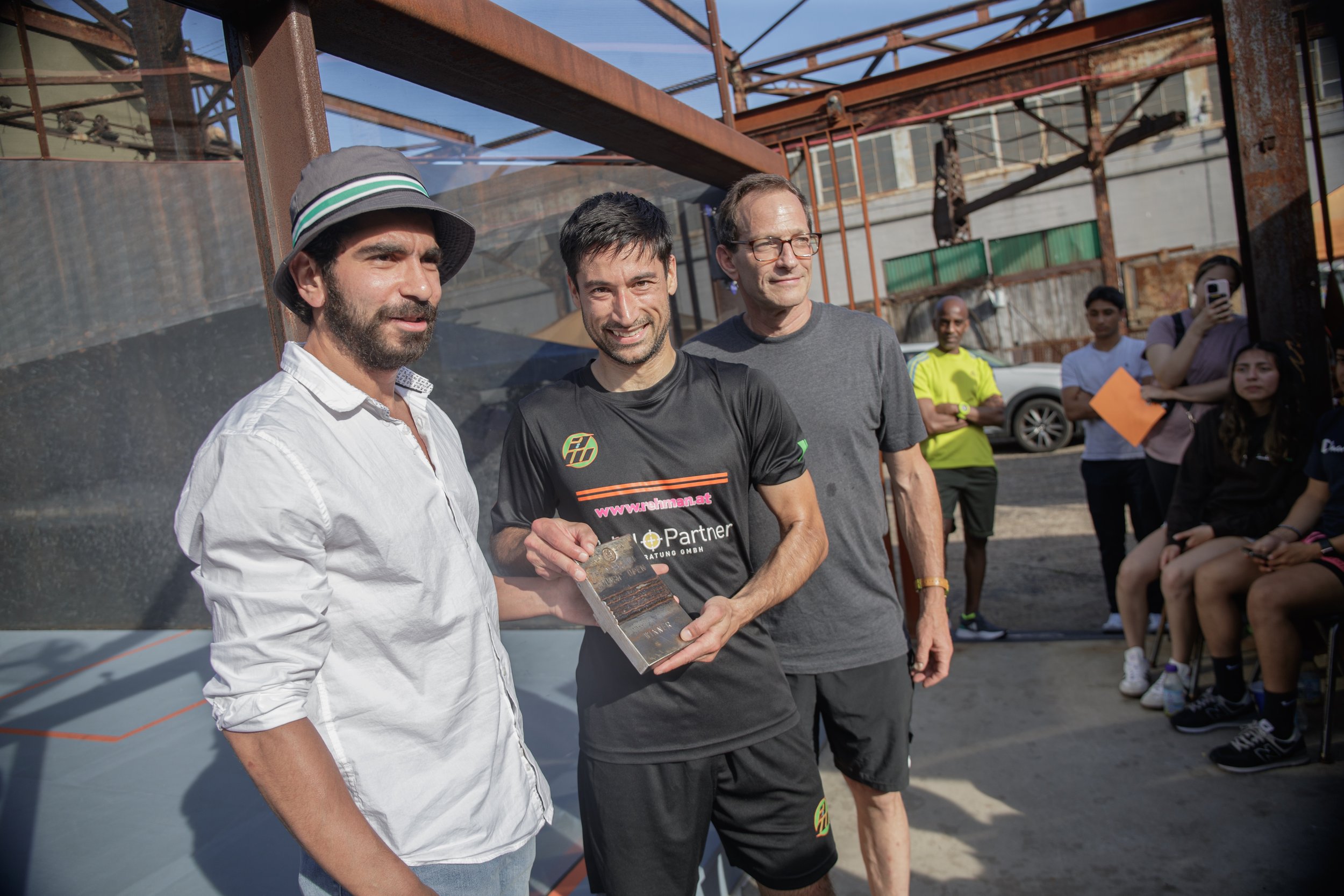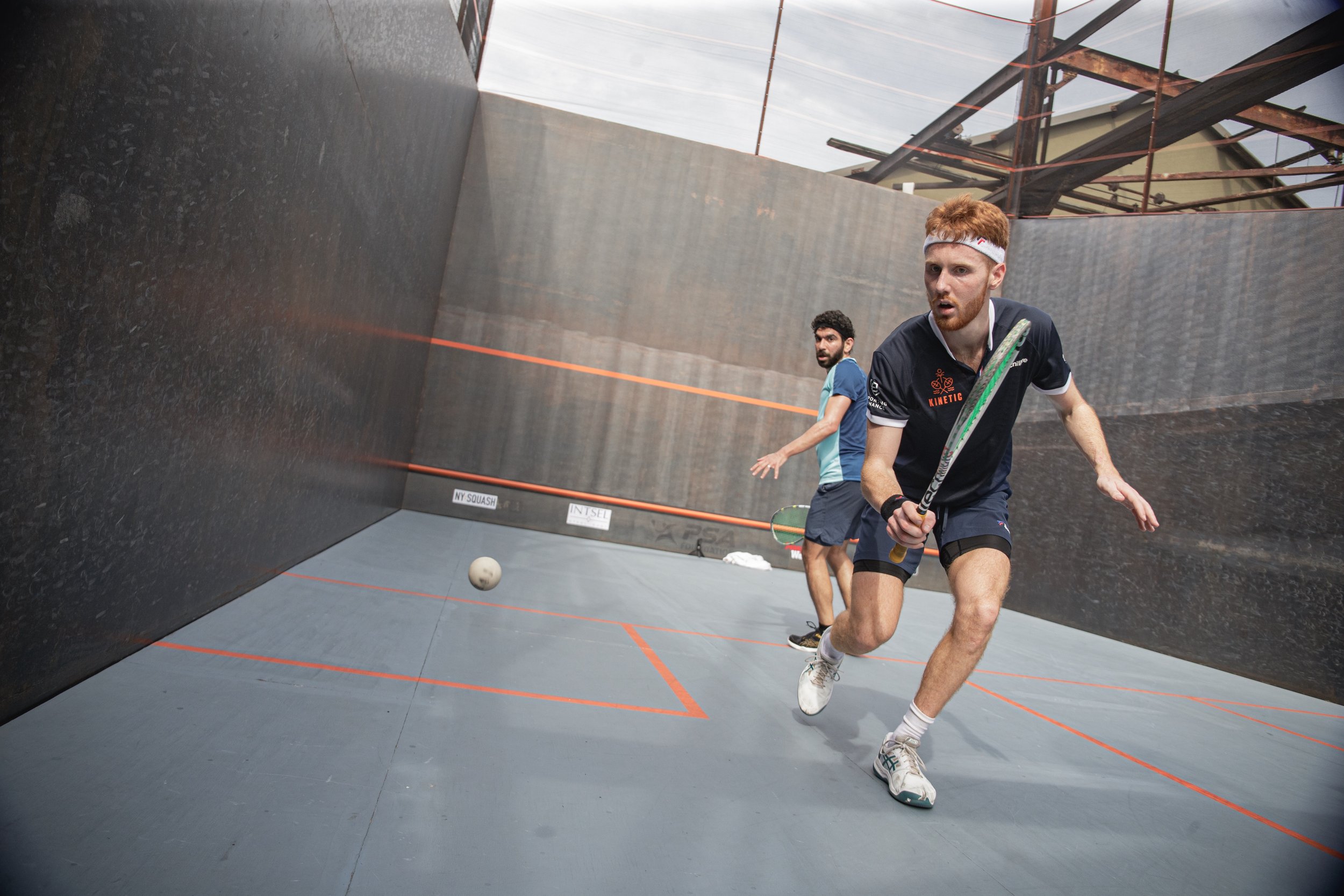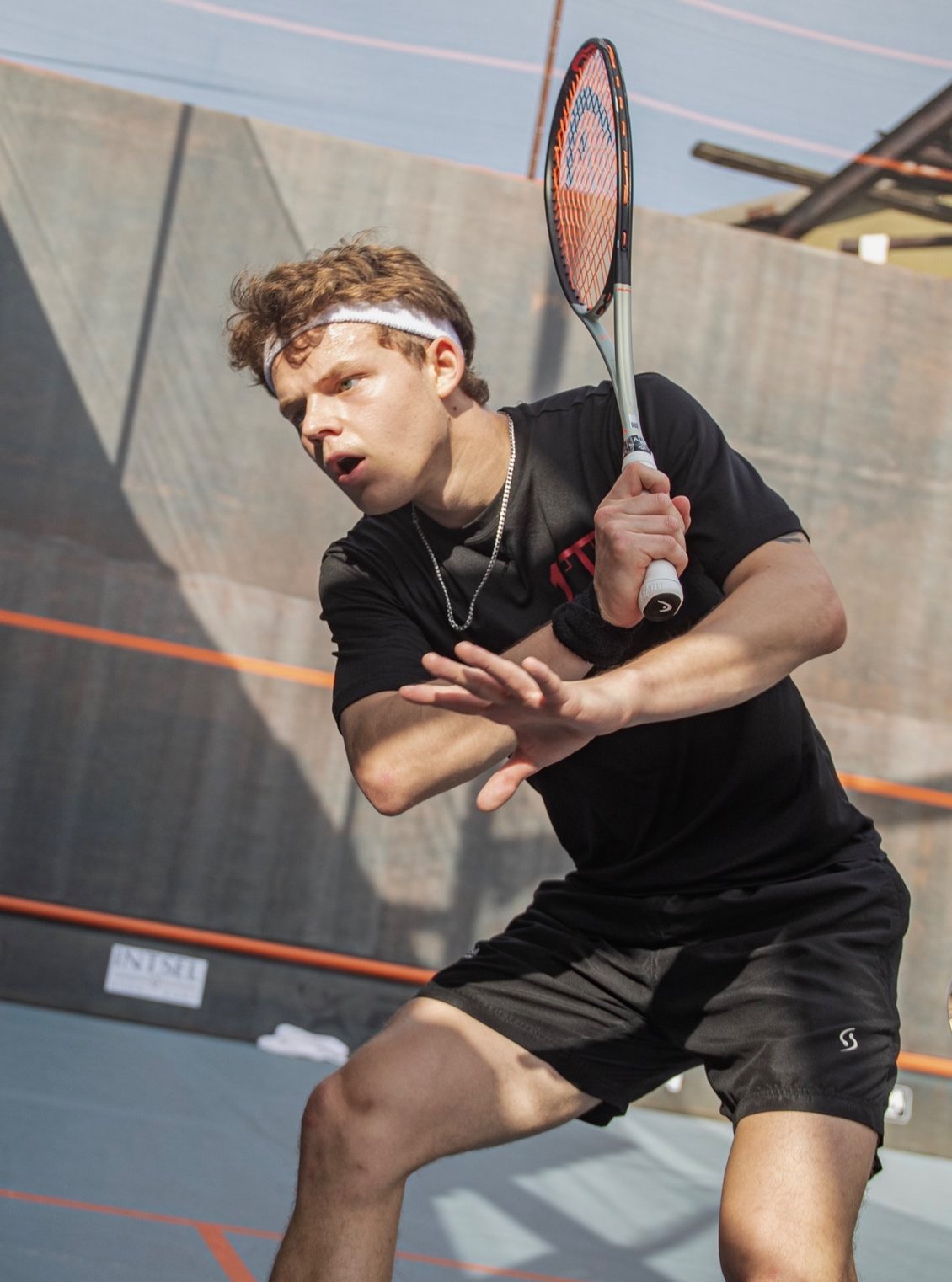Squash Wants To Be A New Thing In The U.S.
After spending a decade witnessing young professional racquetball players fully engage themselves in a sport diminished with opportunity, I find proximity to this set of squash players, has me wondering about growth opportunities in the U.S. and the look to Squash LA28.
The first time I pulled out my camera on the steel court, early round matches of the inaugural Intsel Steel Pro Invitational were underway. The last time I pointed a camera at squash players had to be well over a decade ago. Fresh after covid, the court felt open and unregulated. Seeing squash played in an outdoor setting in a steel yard, felt almost surreal to me.
I knew when I arrived that Mohamed Nabil versus Nathan Lake would be the match-up. Beyond watching Squash TV highlights and a general follow of the very top of the premier rankings, I wasn’t familiar with the pro squash scene here in the U.S. and I didn’t know anything about Nathan Lake at the time. I had, however, made the acquaintance of Mohamed Nabil. We met by-way of the Professional Squash Tour, a start up tour that was working to establish itself in the U.S., an endeavor I comprehensively followed. Nabil, was maybe 19 or 20 when I first had seen him. Back then, he seemed an eager young prospect with hopes to play big-time squash. On this day, still seemingly spry, he seemed to me more of a “local” pro. Meaning no disrespect, I saw, in Nabil, a skilled pro who teaches and trains locally. I didn’t see a touring professional. And again, I didn’t know Nathan at the time and didn’t know what to expect. Honestly, maybe the same, was my initial thought.
In the same sense, I really didn’t know what to expect for the Intsel Invitational as an event. Firstly, who would want to play an outdoor squash tournament in NYC? What level of player could I reasonably expect to see. Indeed relative for me in this sense. The Instel is a “Pro Invitational.” “Pro” is a loaded word for me. When I hear pro, I instinctively turn my inner-head towards rankings. But professional does not always mean that. Except, maybe when you are one. I’d argue that anyone hovering around the “pro'‘ moniker in the world of squash has either toured or contemplated touring as a professional player at one point in their lives.
There was also the formatting to initially consider. Self-reffing. The Intsel is a ref your own matches kind-of-deal. Players are expected to show up and facilitate through their own matches. Everyone else just watches, unless coaches, family or friends want to offer up advice or encouragement between games. It was interesting to consider; I knew I’d have a chance to take a look at personalities a bit more comprehensively. Kind of a fast track to understanding three things in my head. What this particular competition meant to them, the amount of drive they would exhibit on the court and how they competitively interacted with their opponents. Think of self-reffing as turbo for that last aspect.
As the Intsel continued into more developed matchmaking, I signed on to the team and right into photgraphing my first women’s match. Again, I didn’t know what to expect. Both Alina Bushma and Akanksha Salunkhe presented as young, hungry athletes playing a world class level. Though that could be considered a widely general term. Look today, and you will find both of these young women are ranked within the top 100 on the PSA World Tour. Indeed the PSA is a global tour, so, no small feat. So, that kind of world class. You have to stay busy to find yourself in that class. How are they doing it? Where are they traveling to compete? These thoughts would become a prevailing curiosity for me, as I became more familiar with the players filtering onto the steel court.
OBSERVABLE SPACE
As I put this together, I’ll note that both my first Men’s and Women’s match experiences on the steel court had future Intsel champions playing in them. Nathan Lake is the 2021 Intsel Champion and is currently ranked 24th on the PSA Tour. Alina Bushma, who is currently ranked 77th on that same tour, is our latest reigning 2023 Intsel Women’s Champion. I note them, as the fact feels serendipitous to my growing perspective. Nathan is in his early 30’s and continuing his career pursuit, complete with comprehensively sharing his journey as an athlete via newsletter. Alina, impressively, had to work through players ranked considerably higher than her on the PSA World Tour. That many of these players hover in the rankings where they do, relative to the world, only increases my curiosity, the more I follow squash.
Sir Robert is always ready to enhance the experience for the space with details about each player, matching factoids to the faces. That’s usually the start for me. Then, I watch how they compete. All the players go through the motions of prepping prior to a match. As professionals do. Their comfort level setting themselves up, as well as their focus on the match at hand measures easily in this secluded space.
The comfort box adjacent to the court isn’t a huge space. I’d describe it as having that contemporary, city-rustic feel, complete with beautifully rusted fences, solid wood benching and movable, mixed up chairs and beautiful heavy-scrap metal art. Better to describe it as cozy for small groups. It allows for easy engagement. The players, besides reffing their own matches also set up their game times. What could seem like the middle of nowhere-industrial Queens, means making arrangements tend to end up complicated for some. Most players come with a friend or family member, though it isn’t unusual for some to fly solo. Some of our matches garner attention, then the space gets really intimate. Which may or may not be challenging for the players. The players who are familiar with each other accustom themselves to the friendly space quickly. That part interests me though. In my view, if you can’t thrive being shoulder-to-shoulder court side, how in the world can you thrive as a squash pro? Glass courts aside, what’s the reality for most playing professionals? I completely understand though, it’s a new environment and players have their individual strengths.
Steel Firsts: Image Gallery ...view more.
Steel Firsts: Image Gallery ...view more.
They are all professional. What began as a New York centric event manages a solid representation of the strengths of American squash, in my opinion. Teaching professionals. Former touring professionals. Young, in and fresh-out of college hopefuls. A cross-section of high-level squash experience. Most of whom I’ve learned about and met for the first time at Maspeth Squash. Coincidentally, Mo Nabil wasn’t the only player I had prior knowledge of. Ned Marks, like Mo Nabil, played in the first Intsel draw and was also very busy with the now defunct Pro Squash Tour. Ned was fresh out of college and hungry to play professionally back then.
Ned Marks with Timmy Brownell
THE SAME. BUT DIFFERENT.
Ned Marks was banned from playing the PSA Tour a decade ago. I had to dig back a bit to remember that fact. Seems crazy now but back then, the PSA took serious issue with Joe McManus and his PST. McManus saw there where enough locations to showcase touring pros and the PSA’s lack of development in that space at the time. To make a play, he needed some big squash names and he got some. A tour is basically a series manifested with event planning. If you have a consistent crew of highly-elite players (a top-ranked set) that locales can promote at their venues, you can build attention. McManus managed some impressive names, especially if you’re a long-time squash head. Bradley Ball, John White, a young Mohamed ElSherbini and John Rooney were some of the big names he managed to corral into his endeavor.
Pro Squash Tour info circa 2011
Nabil’s PST player page
His early professional experiences could be viewed as uniquely impressive today. Though calling him a journeyman in the midst of a revolving door of notable names couldn’t be considered wrong either. There is energy and there is perspective. The freshness Marks exuded back then echos through what I see from some of younger Intsel players. Today, players have more tools to enhance and reflect their occupation. More over, there seems to be a splash of industriousness as new avenues to showcase squash in the US. are being self-produced by a brash set of them.
SHOWCASE TOURING
When I see Timmy Brownell move through a crowd after having played a match at Maspeth, I see someone who is proficient with his obligation to spectators. Timmy himself, may not see it as such, though I’m sure he understands how being personable facilitates his career. The young professionals that have played our niche tournaments have generally proven well-versed when shoulder-to-shoulder. Most, not all. As enthusiasts in this sport, there is an unwritten expectation some of us have, of players we highlight and watch, expecting them to be affable with us just off the court. Especially given the mostly intimate nature of most squash venues. In that view, I’ll just say Timmy is really good at it. I’ll clarify that I view a well-groomed, court-side manner as an obligation for aspiring professionals. Though, having spent some time now with Sir Robert, I’d probably be more inclined to swap my choice word obligation for undertaking. Whether Timmy recognizes it as an obligation or an undertaking, he and his cohort are all ready making promises about how spectators will feel about having them up close.
National Squash League (NSL)
NSL Statement:
The start of the National Squash League stemmed from one question: What is missing from professional squash?
For some reason, professional squash events fall flat from the fan perspective.
Why is that?
We’ve created the National Squash League to solve that problem.
The NSL is a team and city based league similar to other major league sports in the USA. The scoring format is unprecedented and enhances squash’s fast-paced and tactical qualities to constantly re-engage viewers.
The competition consists of a 3 vs 3 team match played over 3 periods of timed squash, the first two periods being 20 minutes in duration and the third and final period being 30 minutes. The play during the periods is PAR and the first two periods are worth one point each, whereas the 3rd is worth two. In the event of a tie, one five minute overtime period is played. During the periods, each team is entitled to a predetermined number of substitutions, which can be made at any time. Each team is also entitled to a predetermined number of power plays during each period in which the team that activates it is the only one to score points for a 2 minute duration.
The “regular season” will be contested in a group stage format consisting of two groups of three teams in a North and South division. The winner of each group will play to be crowned the first NSL champion in one final match!
Read more about the rules HERE.
Fernando Valdizan (a squash fan from Louisville), along with Timmy Brownell and Spencer Lovejoy founded the league. That is how it was communicated to me by Timmy. The website asks upfront, What is missing from professional squash? Then continues on, answering by stating squash is falling flat from a fan perspective, then asks why. (In my experience, an existential question all sporting events face.) Their answer comes with the promise of structure and formatting. But is that what’s needed?
Slick promo videos and website graphics promise more than just that. The NSL flashes the promise of marquee players, complete with trading card styled player bio pages and running info on the drafting process, as they organize into teams. That’s all I will move into with explanation. Anything more requires the added time of understanding the ideation. Just know there is a promise from the NSL by dint of structure. I’ll opine it as a hard ask upfront. And sounds costly for benefactors up front, judging from what I heard on the Rally Report. I will also bring to attention the programming for the stream is comprehensive. They’ll have to replicate that each time. Indeed bold promises. While this is promising to you, there is also a promise to the players. It promises these professionals and aspiring professionals a paying opportunity to distinguish themselves in front of a crowd. Let me rephrase that. For these players, the NSL is the promise of paying opportunity to be professional in front of fans, there to see them.
TOUR TIMING
At the end of the day, this play by Timmy and Spencer will create structured playing experiences for themselves and their cohort. Or, I could respectfully ask if they are attempting more by trying to create something truly different that can grow into sustainability? Because at the very base level, players will be playing squash in front of fans and prospective fans, that’s all. Formatting and time adjustments aside. I believe it would be fair question. Getting the fans excited and thinking differently about those situational differences falls into the realistic realm of event planning.
Canadians Connor Turk and Brett Schille,
Maspeth PSA Challenger, early round,
Rain-relocated to The Harvard
Coincidentally enough for me, Mohamed Nabil also ventured to create a playing opportunity for himself, and a certain set of players. It wasn’t as ambitious as creating something new, but it did involve event planning. He did it here, on the steel court. Or mostly on the steel court. Nabil served as promoter for the first ever PSA Challenger Tour event played on an outdoor court. Well, somewhat played on the outdoor court. Rain forced the first two rounds into The Harvard Club, (thank you to Richard Chin for the hook up.) That fact didn’t change the way Nabil competed. He showed up apparently ready, complete with trainer and looked focused to advance. It seemed very easy to see. He showed up early. He had visited the court with his trainer prior to the event. He took great pains to properly get himself where he felt he needed to be to compete. I had seen him at the Intsel and can say he showed up way more focused for the Challenger.
Ironically, at the Harvard Club, that first round felt familiar to me. It was the proximity of everything off the court in the space. It felt typical to me. Racquetball subsists in spaces that would be described by the layman (or woman,) as exactly the same. It instantly reminded me of my time with the pro tours in that sport. Same energy and for the most part, international players. I just know these players are well-accustomed to walking past other sport set-ups or gymnasiums to get to the courts, adept at shimmying around spectators in small spaces, as they walk on court.
Who are these guys who showed up for the PSA Challenger? How were they made aware of the event? I know these questions may have easy answers, but as a squash outsider, I was wondrous of the squash circuit in the U.S. Most of these guys were international players and presented singularly focused on chasing points. I knew I could look at the PSA website for the Challenger schedule. And I did. And as listed, it looks thin. And I’m still very curious about how that series tracks here in the States.
PSA Challenger Events in the US this (2023-2024) season. (Based on events listed on the PSA World Tour website.)
• 18 opportunities with prize money $6K and over for men.
• 8 opportunities with prize money $12K and over for men.
• 4 event opportunities with prize money $12k and over for women.
• 8 event opportunities with prize money $6K and over for women.
What was the typical journey for these athletes? The players in this draw had a combined average of 10.8 events contributing to their overall ranking points on the Challenger Tour as of the end of 2023. Some were indeed busy and a few had a scarcity of attempts at points. Is that indeed what some of these players were chasing? What is the motivation behind the number of players experiencing their professional careers this way. I imagined there may be some government sports funding producing these journeymen. Would I, down the road, see any of these guys on SquashTV? Then again, my experience with squash is relatively light. I’m looking at things from point-of-purchase.
HARD COMPARISONS
Timmy Brownell however, is currently fast-tracking on the PSA World Tour, increasingly racking up valuable court-time with some of the PSA’s premier players. Which means he’s very busy. Busy doesn’t mean shine though. Eventually, without shine busy is just work in this world. Like Timmy, these players seem busy. As I think about it, every player I’ve encountered through the Intsel or the Challenger seemed to be pretty darn busy with the sport of squash.
The NSL is guaranteed money plus expenses from their player’s perspective. “We’re such fans of squash, too. We kinda know what squash has been starving for, people being able to engage with the players, we don’t get to see who these guys are.” I agree with this statement in principle, to a certain extent. Rubbing shoulders, glad-handing and remembering names, will be fundamentally needed here. They’re being paid to be seen playing their new game. The return is the promise of the thrill the new team play format can generate. And the ability to engage, when brought to clarity must prove bankable.
I remember hearing or reading somewhere that the U.S. is home to about 30% of PSA world tour tournaments. Whether it rings true or not, I’m curious to know how these players are professionally engaged in accumulating points on the Challenger. How are they doing that in the U.S.? Are they all full-time squash players? For sure, the long-time squash heads I run across all have been sketchy on their knowledge of the Challenger. I’m talking about guys who will talk squash for hours. And yes, I know they stream all the time. But squash, forgive me, can get repetitive and just present as random to a casual fan. The PSA Challenger is not an easy thing to get excited about in the United States.
Squash Crowd Love - Courtesy NSL Website
They promise to make it fun. My big assumption in all of this, is that they, mostly, will be hosting the National Squash League in the smallish spaces of private clubs or for-the-public squash establishments. I see a lot of friction with time-management, space management with player transitions and content creation. Streaming is easy, but still/maybe reliant on the host site for internet access. Sustaining regularity in all of this is something the league will have to learn about and accomplish the hard way. As long as the players they bring in understand the most important piece they can produce, aside from their particular strength they bring to a team, is their ability to be all about their teams and their fans. That would be the person-to-person ability to be noticed/liked/remembered, ensuring the “fun”, in connection with the team styled format.
Indeed, the NSL’s longevity will be crucially dependent on the energy reflected out by their players. Squash enthusiasts are busy. Active with their own experiences. They’re probably already heavily following what happens on the PSA. Or in their own club. And on their own phones.
Oh. The phone. Will NSL fans be taking the new formats home with them in their heads enough to care, share or follow? Not only will the new team squash formatting need to be digestible, it will need to compete with everything else squash. And everything else cultural. Because at the end of the day, there is already only a finite room in people’s daily intake of it from what I know of most squash enthusiasts. It takes a special something for someone to learn to love a sport with a ball that doesn’t bounce very well initially. That’s coming from someone at ten thousand feet. My take on it is, that, if someone has invested so much time to keeping that dead ball bouncing, they're doing it in groups during the week, often. All that to say, there is obscene amount of squash being played and followed by enthusiasts. The NSL will land be an add-on for anyone. The smartphones that they’ll see those cool promos on will also be bombarded by the cultural plays of other playable/accessible sports. I see the growth of pickleball and padel, with the noise they make in the team-league development culture-space as something the NSL will be sifting through for attention. It would be reasonable to ask if the team-squash thing influenced by the trends these fast growing sports are pushing?
CULTURE PLAY
The big deal for me is LA28. Squash has been forming foundations outside of the collegial clubs and it has seeded well. I see plans for more building all over the place. For me, that is an opportunity to engrain the game in the consciousness of the U.S. Judging from the players I witness playing on the steel court, there is a lot to get excited about with squash. These players are seriously attractive when they do what they do. I can see packaging them and branding them and touring them in specific locales. Like a tour. Like the new NSL. That’s why I can’t not-like the energy they’re bringing. The thirst for their sport. The energy has me seriously asking, where are the women? First, know I asked that last question more in reflection of my own thoughts, than the NSL’s omission. The women’s game is super-aggressive today. Impressive enough to highlight continually. I’d even argue that under today’s type of touring conditions, it would be easier to build around some of the women, judging from what I’ve seen on the steel court and on the PSA today.
Squash is slowly beginning to speak to a different set of people than it did ten years ago. It seems like there is an incredible amount of money being dropped on the PSA’s media flow. That definitely helps. But what slams it home for me as a casual fan is the growth of educational programs and the growing number of stand alone squash locales. I don’t remember squash running so deep in the U.S. a decade ago.
Mohamed ElShorbagy & Timmy Brownell
2023 U.S. Open - Arlen Specter Center
Case in point. I recently saw Timmy playing on the same livestream as Mohamed ElSherbini, whom I mentioned played for the PST. It felt substantive to my over all feelings about the drive to stay in the game. I saw ElSherbini as he was being introduced to fans before he entered the court over as a fresh, young pro prospect and a bit surprising for me to see him still working the game. I’ll rephrase this too. It was cool to see him on the livestream. Likewise, it was cool to see Timmy playing Mohamed Elshorbagy at the U.S. Open. I generally-consider Elshorbagy as my favorite player. I don’t fanboy, but my time-to-date following squash coincides with the prime of his play. I feel like I’ve watched his career play out through PSA highlights. That I was introduced to Timmy as player for the Intsel Invitational and then coming to learn more about him, made it different for me, as a fan. I met and spoke with Timmy just outside a squash court. I was activated as a fan as I found myself rooting for him as he played Elshorbagy.
The growth squash is experiencing isn’t the type that overtakes popular culture with a bang or a rush. That’s never going to happen. It wouldn’t be a bad play though, to find a way to get behind this current crop of players and build a seeable, accessible route for young touring professionals in the U.S. If that push could be visual and easy to follow, designed to create shared experiences in specific markets leading to LA28, I could see that garnering attention. Make squash easily digestible with players who seem to dream Olympic.
Absolutely no doubt in my mind that there are plans by the squash-head organizations to up their programing using LA28 as a vibe check. Everyone in the game should be warming up their elevator pitches. For most of the U.S., squash will be a new thing to become familiar with as we approach the Olympics. I will be curious to see, when the world watches, if more Americans have a truer understanding of squash. And whether professionals working in the U.S. engaging their craft on the other side of the glass experienced some shine going in.
Today I will ask, How many aspiring PSA professionals, living and working in the U.S. will experience real growth in their careers between now and 2028?
Experience Playing Squash At Maspeth Squash
Steel Firsts: Image Gallery ...view more.
Steel Firsts: Image Gallery ...view more.
For the professional squash player, to be seen playing is a major goal. Because squash people love to watch squash. The pro wants people to watch them, as much as they want the achievement. It’s a shared experience with the watching fan. Fans of squash like to focus on players as a subcomponent of the joy in their squash experience. The more comprehensive their knowledge of the game and the particular players, the bigger and more meaningful the experience will be for them. It’s safe to say, some squash pros get the way bigger experiences, with a ton more sharing.
We want to see you playing.

